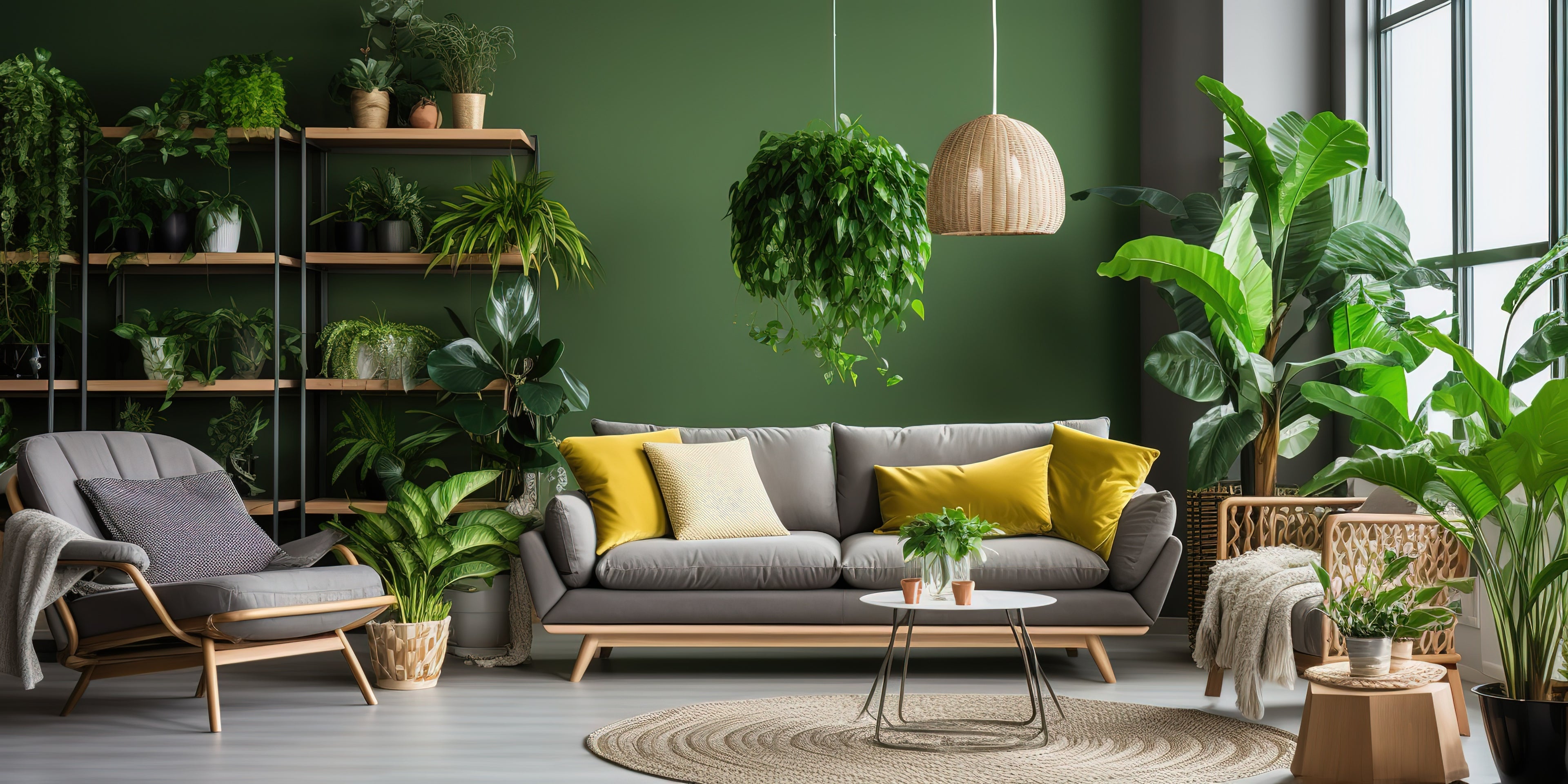
Whether you have a small apartment with no yard, or just want to add some more greenery to your life, we have the houseplant for you. And, don’t forget about the other people in your life! Indoor plants and flowers are a favorite item to share with another and some are even associated with things like luck, love, and health. Don’t know what your mom wants for Mother’s Day? We can help you pick out a lively, colorful house plant. Did a friend just move to a new place? What is better then some lush greenery to make a new home cozy and inviting?
Swing by our ever changing gift shop to check out the great variety we have to offer!
General Care Tips
Light & Temperature
A big key to successful houseplant growing is placing them in the correct light and temperature locations. Houseplants do not like to be moved too often, so it is a good idea to place the right plant in the right place from the beginning of it’s life as part of your family.
Soil
Houseplants prefer a soilless medium to grow in, typically a basic potting soil will do, but cacti, succulents and orchids will do better with a medium that is suited specifically for them.
Water
The easiest way to kill a houseplant is over watering. Most houseplants can recover from too little water, but rarely can they recover from too being over-saturated with water. Rather than using a calendar method to water a plant, use the finger test method. Before watering, dig your finger 2″ down into the soil and check the moisture. If it is still damp, do not water, if it is dry, you can water.
Fertilizer
Houseplants best fertilized when they are most actively growing, which is typically between March and September. We recommend fertilizing once every 1 to 3 months during the growing season. During the winter they tend to go through a rest period and do not need additional fertilizing. Fertilizers specially labeled for houseplants work best. To avoid salt build up from fertilizers, it is good to leach the pot every 4-6 months by pouring a large volume of plain water into the pot and letting it drain completely in a sink.
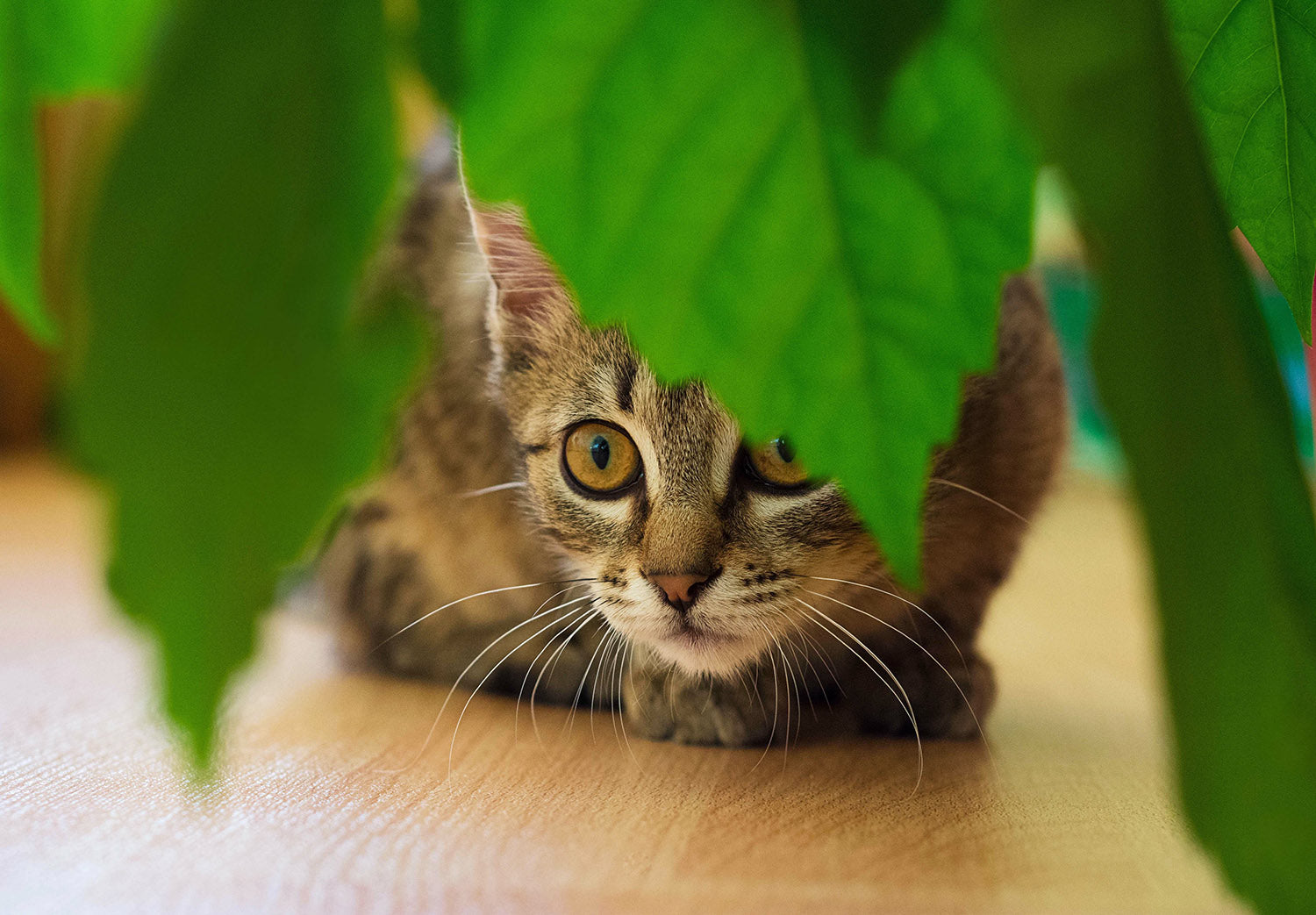
Pet-Safe Plants
If you are a pet owner, chances are one of the primary considerations when looking to add a new plant to the mix, is “Will this be safe for my pet?”
So we’ve put together a quick reference list of all our favorite pet-friendly houseplants that are completely non-toxic and safe for you canine and feline friends. Plus, a handful of toxic ones that you might want to avoid.
Collapsible content
Our Favorite Common Pet-Safe Houseplants
- African Violets (Saintpaulia)
- Aluminum Plant (Pilea cadierei)
- Baby Tears (Soleirolia soleirolii)
- Bromeliads-ALL!
- Birds Nest Fern (Asplenium nidus)
- Boston Fern (Nephrolepis exaltata)
- Calatheas-ALL!
- Christmas Cactus (Schlumbergera or Zygocactus)
- Lipstick Plant (Aeschynanthus radicans)
- Haworthia fasciata
- Hens and chicks (Sempervivum tectorum)
- Maiden Hair Fern (Adiantum)
- Moth Orchid (Phalaenopsis)
- Parlor Palm (Chamaedorea elegans)
- Peperomia-ALL!
- Pilea–ALL!
- Polka Dot Plant (Hypoestes phyllostachya)
- Prayer Plant (Maranta Leuconeura)
- Polka Dot Plant (Hypoestes phyllostachya)
- Prayer Plant (Maranta leuconeura)
- Rex Begonia (Cissus dicolor)
- Spider Plant (Chlorophytum comosum)
- Staghorn Fern (Platycerium bifurcatum)
- String of Hearts (Ceropegia woodii)
- Venus Flytraps (Dionaea muscipula)
Toxic Houseplants to Avoid
- Arrowhead (Sygonium podophyllum)
- Aloe (Aloe vera)
- Asparagus Fern (Asparagus setaceus)
- Caladium (Caladium sp.)
- Chinese Evergreen (Aglaonema sp.)
- Cyclamen (Cyclamen sp.)
- Dieffenbachia (Diffenbachia sp.)
- Dracaena (Dracaena sp.)
- Jade (Crassula argentea)
- Kalanchloe (Kalanchloe spp.)
- Monstera (Monstera spp.)
- Narcissus (Narcissus spp.)
- Philodendron (Philodendron spp.)
- Pothos (Pothos spp.
- Sansevieria (Sansevieria spp.)
- ZZ Plant (Zamioculcas zamiifolia)
Identify
To get more detailed instructions on houseplant care it is best to know the exact species you have. While there are general rules to houseplants, certain species require specific environments to thrive.
Some species may have different varieties among that give them more unique characteristics too. A common variation is variegated houseplants, which have lighter colored striations on the leaves than usual.
Low Light Houseplants
-
Arrowhead Plant
Syngonium podophyllum
Size: Medium sized plant. Varieties range from 2′ to ~4′
Light: Grows in low to medium light. Varieties with leaf variegation should be grown in med to high light to keep color saturated.
Water: Allow top 50% of soil to dry out before watering. Leaves droop when it needs water.
Humidity: Prefers high humidity but will tolerate basic household humidity.
Does not normally flower indoors
-
Babies Tears
Soleirolia helxine
Size: Small sized plant. Low growing, ground cover habit, up to 6″.
Light: Will grow in low light but prefers bright, indirect light. Keep out of direct sun.
Water: Keep slightly moist at all times, does not tolerate drying out or soggy soil.
Humidity: Thrives in high humidity.
Likes the environment of a terrarium, but can crowd out other plants.
-
Bird’s Nest Fern
Information SheetAsplenium nidus
Size: Medium sized plant. Typically growing to 2′ in an indoor container.
Light: Grows in low to medium light. Prefers to have filtered indirect light.
Water: Keep soil moist but not soggy. Water the potting mix, not the rosette of the fern.
Humidity: Prefers moderate humidity. Brown leaf tips are a sign that the air is too dry.
It is normal for older, outer fronds to turn brown and die. Cut them off at the base to keep plant looking fresh.
-
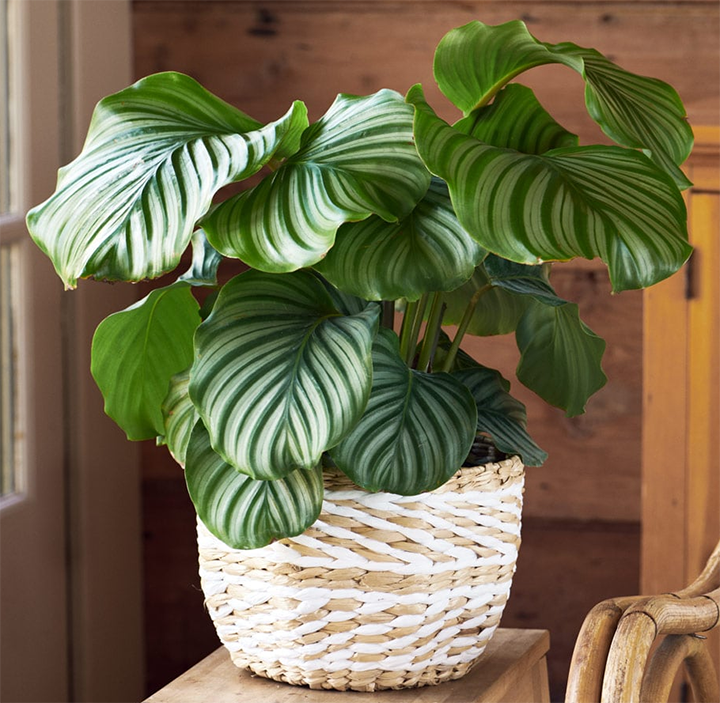
Calathea
Calathea
Size: Medium sized plant. Up to 2′ tall.
Light: Grows in low to medium light. Burns in direct sun.
Water: Keep evenly moist. Prefers distilled water, tends to be sensitive to fluoride and other chemicals in treated water.
Humidity: Prefers high humidity. Mist frequently. Will benefit from having a shallow tray of wet pebbles nearby.
Brown leaf tips indicate low humidity, fluoride in water, or too much fertilizer.
-
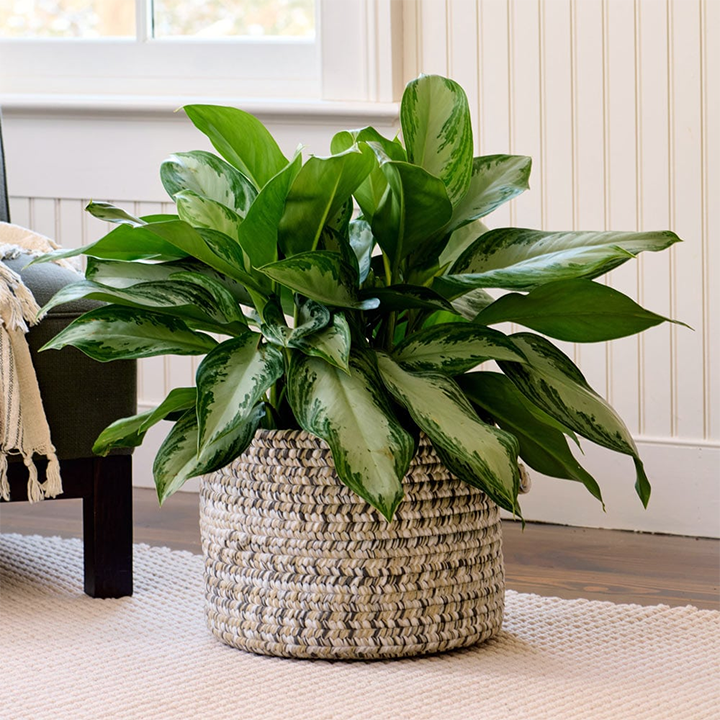
Chinese Evergreen
Aglaonema varieties
Size: Medium sized plant. Up to 2-3′.
Light: Grows well in a low light environment.
Water: Try to keep lightly moist, foliage can yellow if allowed to wilt between watering. Stems rot easily if soil is too wet.
Humidity: Average indoor humidity levels. Does not respond well to misting.
Very easy care plant. Good for an office setting.
-
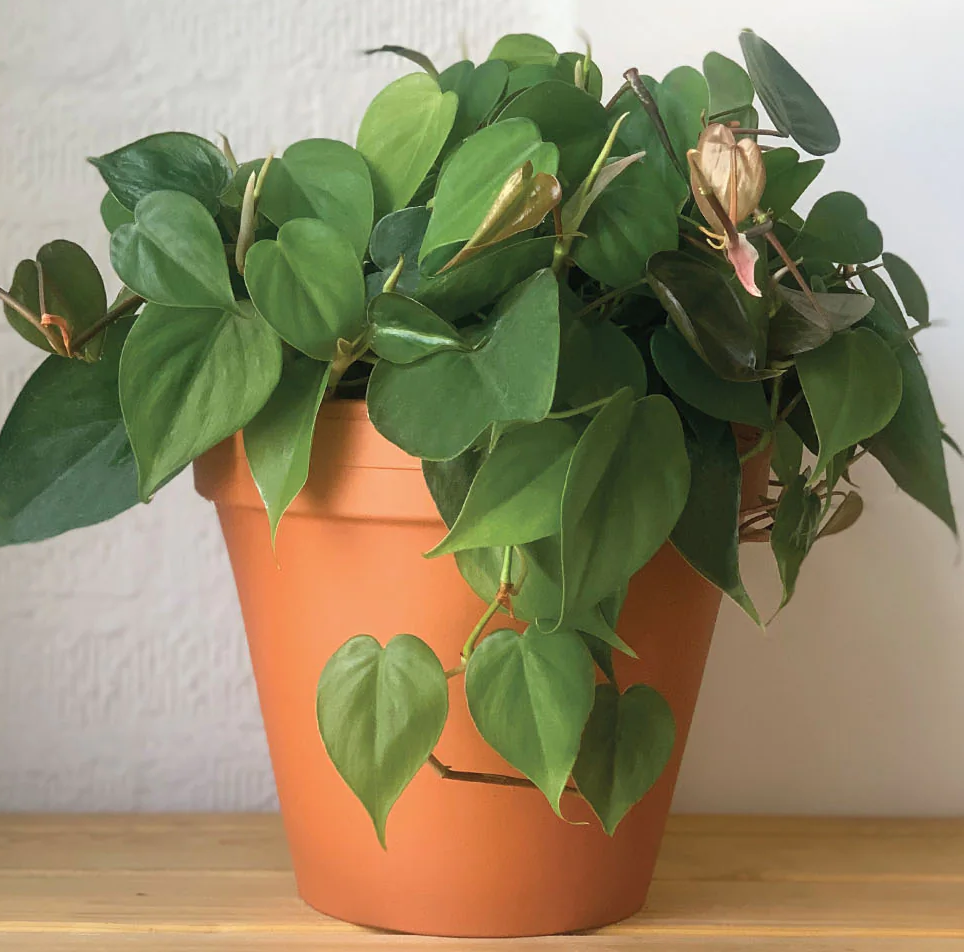
Heart Leaf Philodendron
Philodendron scandens
Size: Medium to large, can climb or trail to 4′ or more.
Light: Grows in low light, but will grow quicker in medium to bright, indirect light. Does not like direct sun.
Water: Keep soil lightly moist white actively growing. Allow top 50% of soil to dry out between watering in winter. Will yellow with over-watering.
Humidity: Tolerates dry air, but prefers more humidity. Mist occasionally.
Very adaptable plant. Pinch back to a leaf node to keep bushy and full.
-
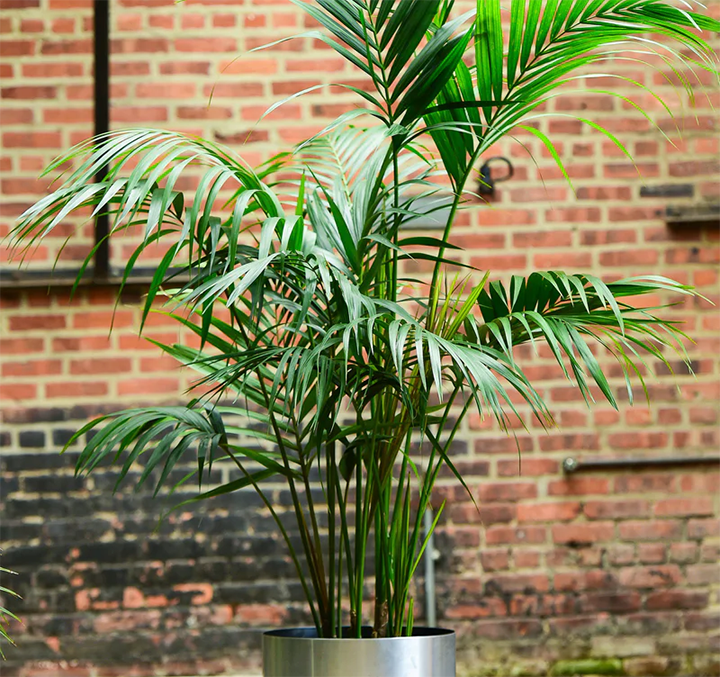
Kentia Palm
Howea forsteriana
Size: Large. Grows slowly up to 8′ indoors.
Light: Tolerant of low light, but will get more vibrant in bright, indirect light.
Water: Keep evenly moist during growing season, drier in the winter.
Humidity: Prefers moderate to high humidity. Mist foliage regularly.
Good as a floor specimen.
-
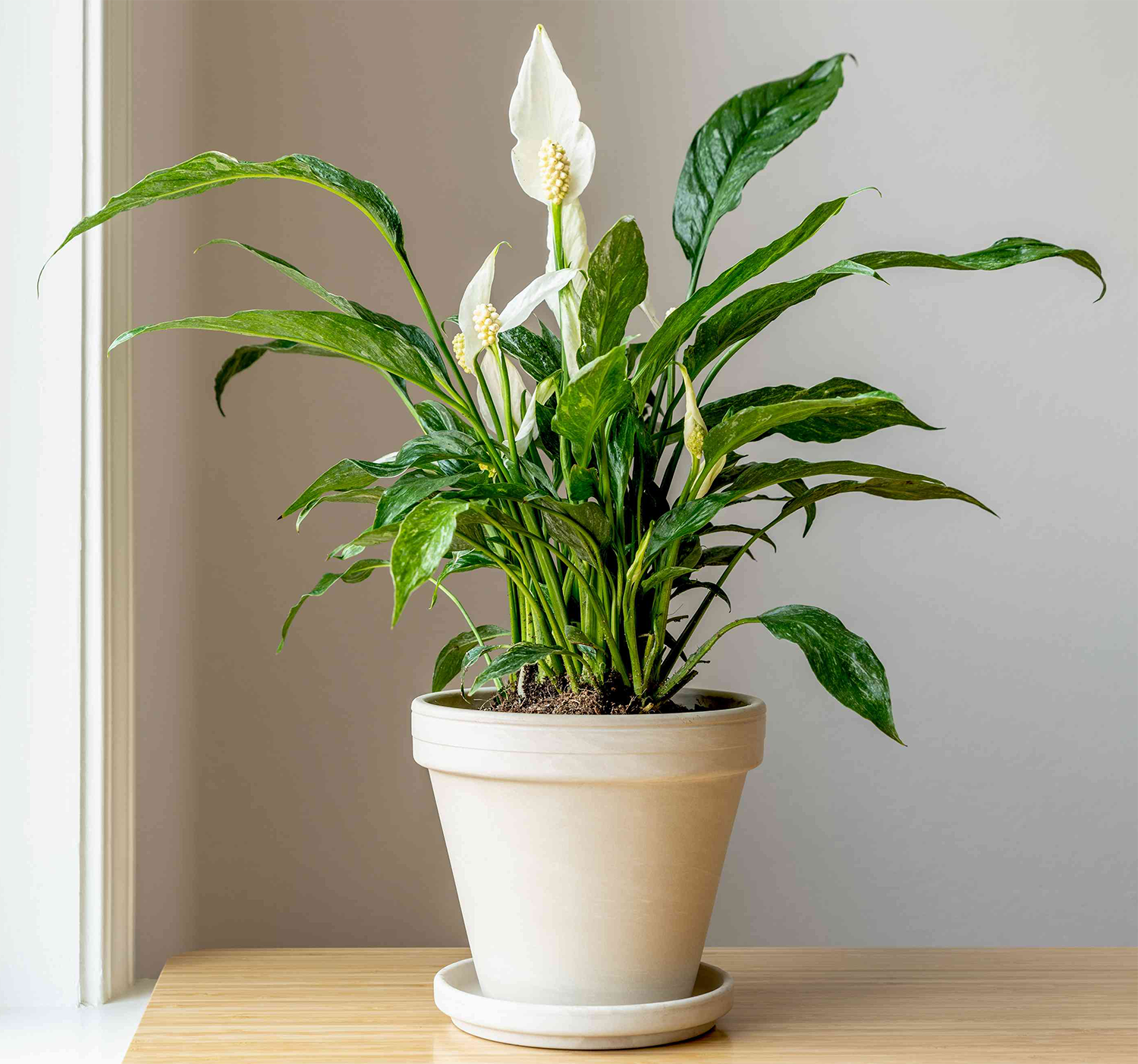
Peace Lily
Spathiphyllum wallisii
Size: Medium, up to 3′ tall.
Light: Tolerates low light well, but may not bloom.
Water: Keep evenly moist. Soggy soil can easily cause root rot.
Humidity: Keep relative humidity. Shriveled, dry leaves are typically a sign of the air being to dry.
Place in indirect, bright light and divide older plant to encourage blooms.
-
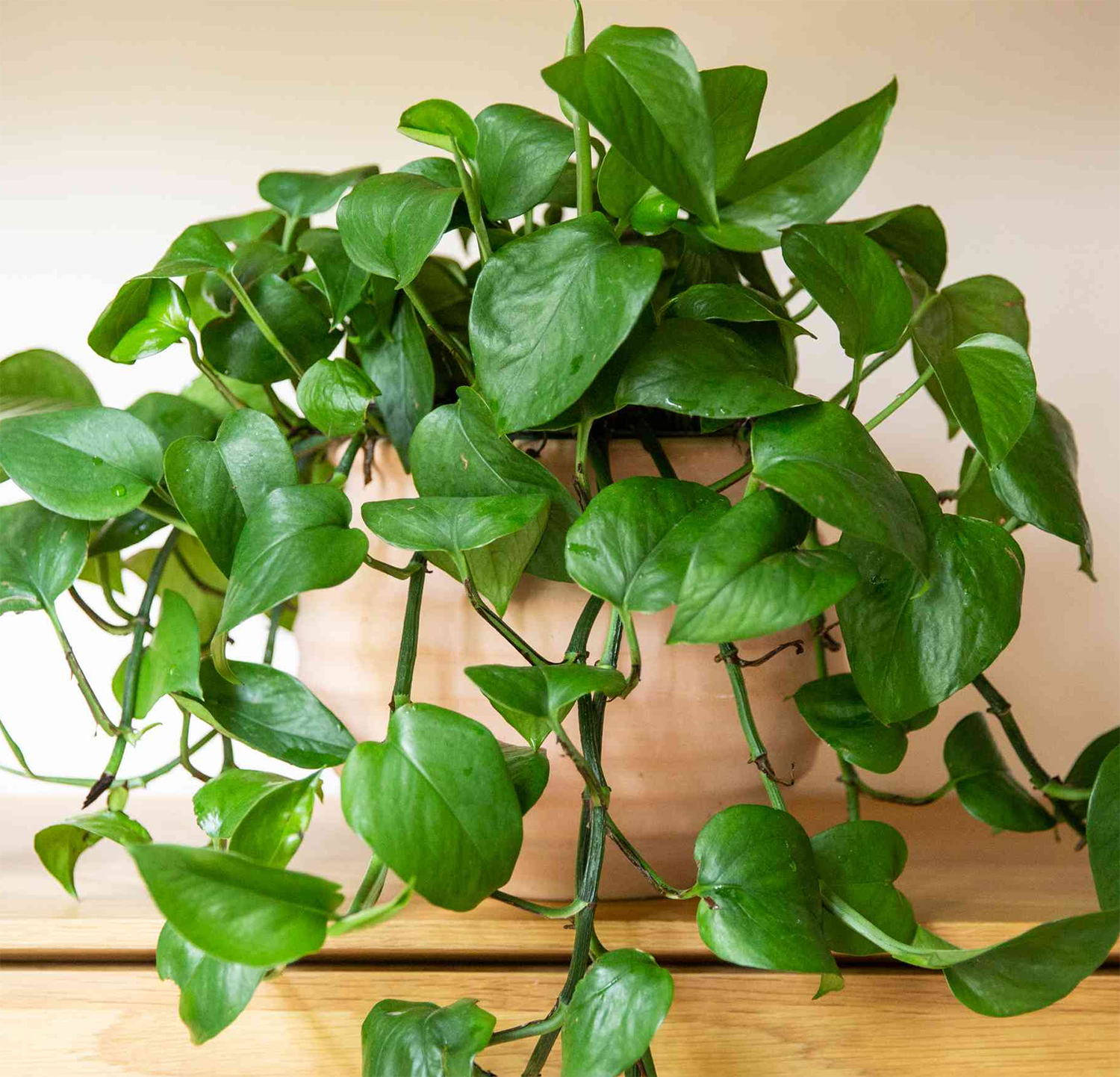
Pothos
Information SheetEpipremnum aureum
Size: Medium to large. Trailing/climbing stems can grow to 8′ or more.
Light: Tolerates low light, but will have more foliage and better variegation with bright, indirect light.
Water: Allow top inch of soil to dry out before waterings. Does not tolerate soggy soil. Foliage yellowing and falling off is a sign of over-watering.
Humidity: Average room humidity or higher. Brown leaf tips indicate too low humidity.
Very east to grow. Trim stems back at leaf nodes to keep a bushy, full habit.
-
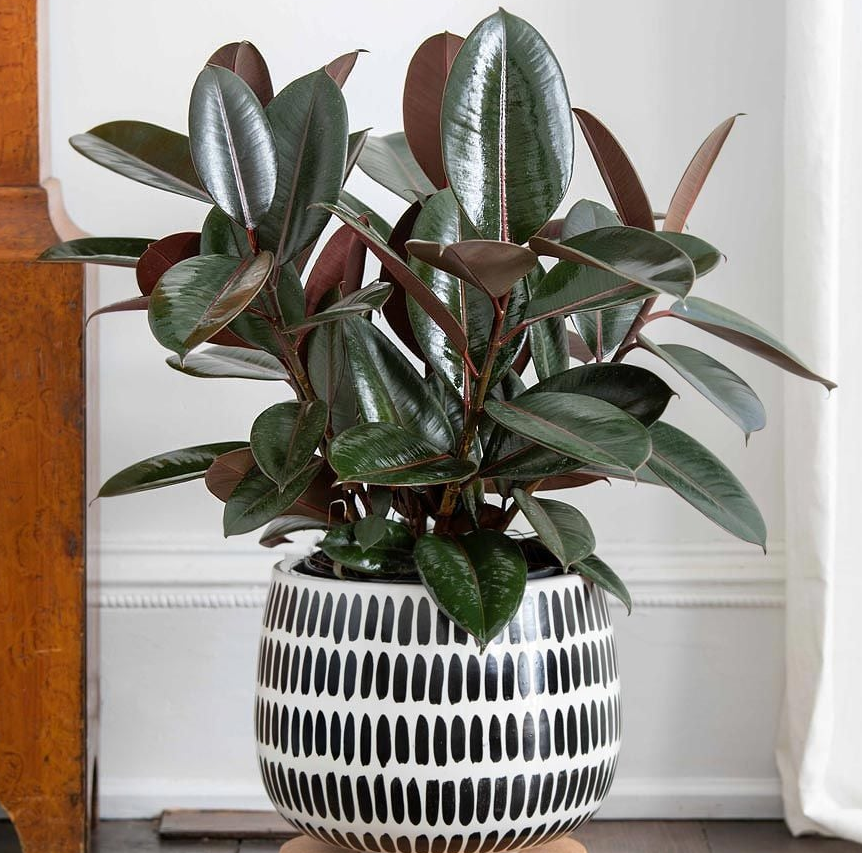
Rubber Tree
Ficus elastica
Size: Large, up to 10′ indoors.
Light: Can tolerate low light, but perform better in bright, indirect light.
Water: Allow top 25% of soil to dry out before watering. Keep soil drier in low light conditions.
Humidity: Average indoor humidity.
Fairly easy care, but does not like to be moved.
-
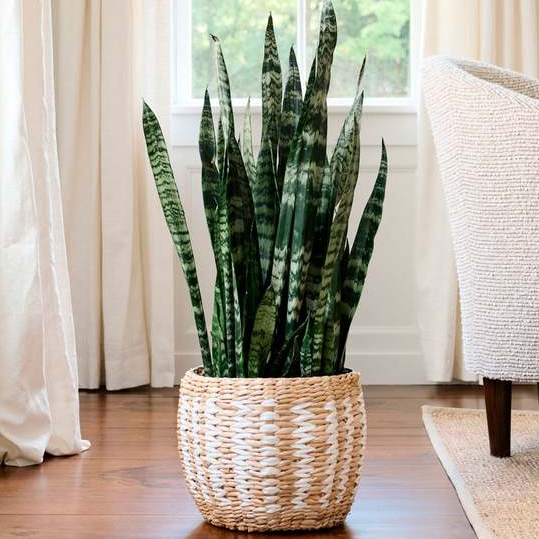
Snake Plant
Sansevieria trifasciata
Size: Medium, typically around 2′ tall indoors.
Light: Tolerates low light but prefers bright light to full sun.
Water: Lightly moist during growing season. Water just enough to keep the soil from drying up completely in winter.
Humidity: Average room humidity. Tolerates dry air, but keep away from vents and drafts.
Carefree plant, great for beginners.
-
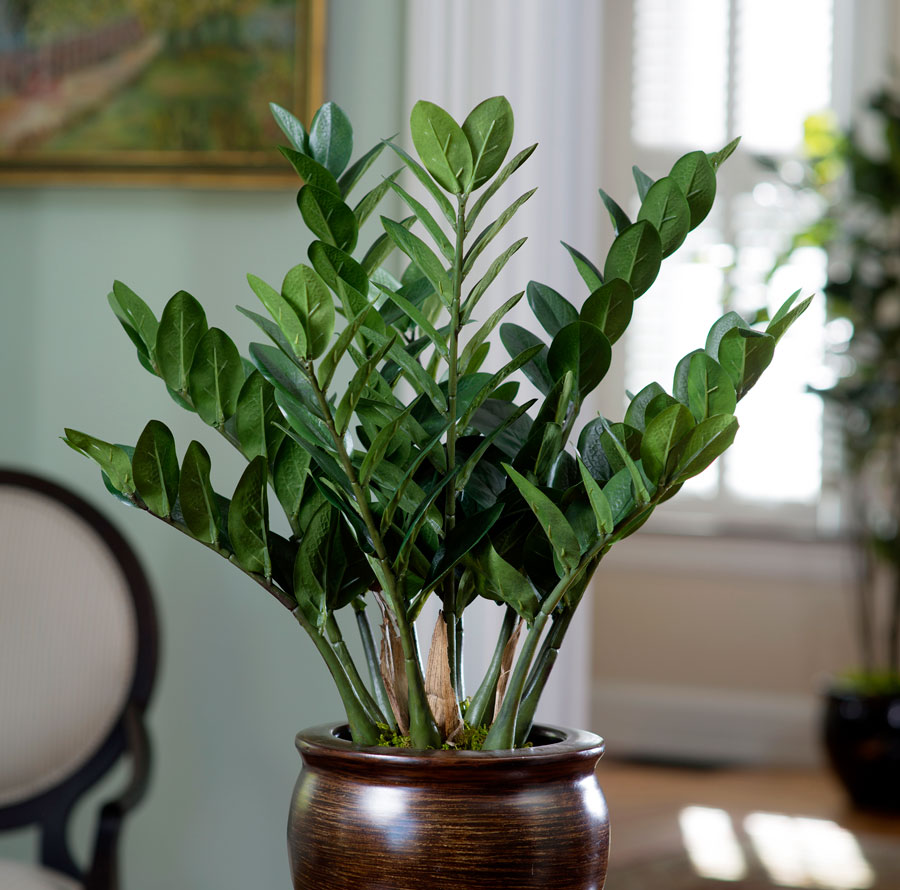
ZZ Plant
Information SheetZamioculcas zamiifolia
Size: Medium, slow growing to 3′ indoors.
Light: Tolerates low light, but happiest in bright, indirect light. Keep out of afternoon, direct sun.
Water: Allow top 2″ of soil to dry out before watering. Rots easily with soggy soil. Yellow stems are a sign of too much water.
Humidity: Average room humidity. Tolerates low humidity.
Rarely has pest problems.
Medium Light Houseplants
-
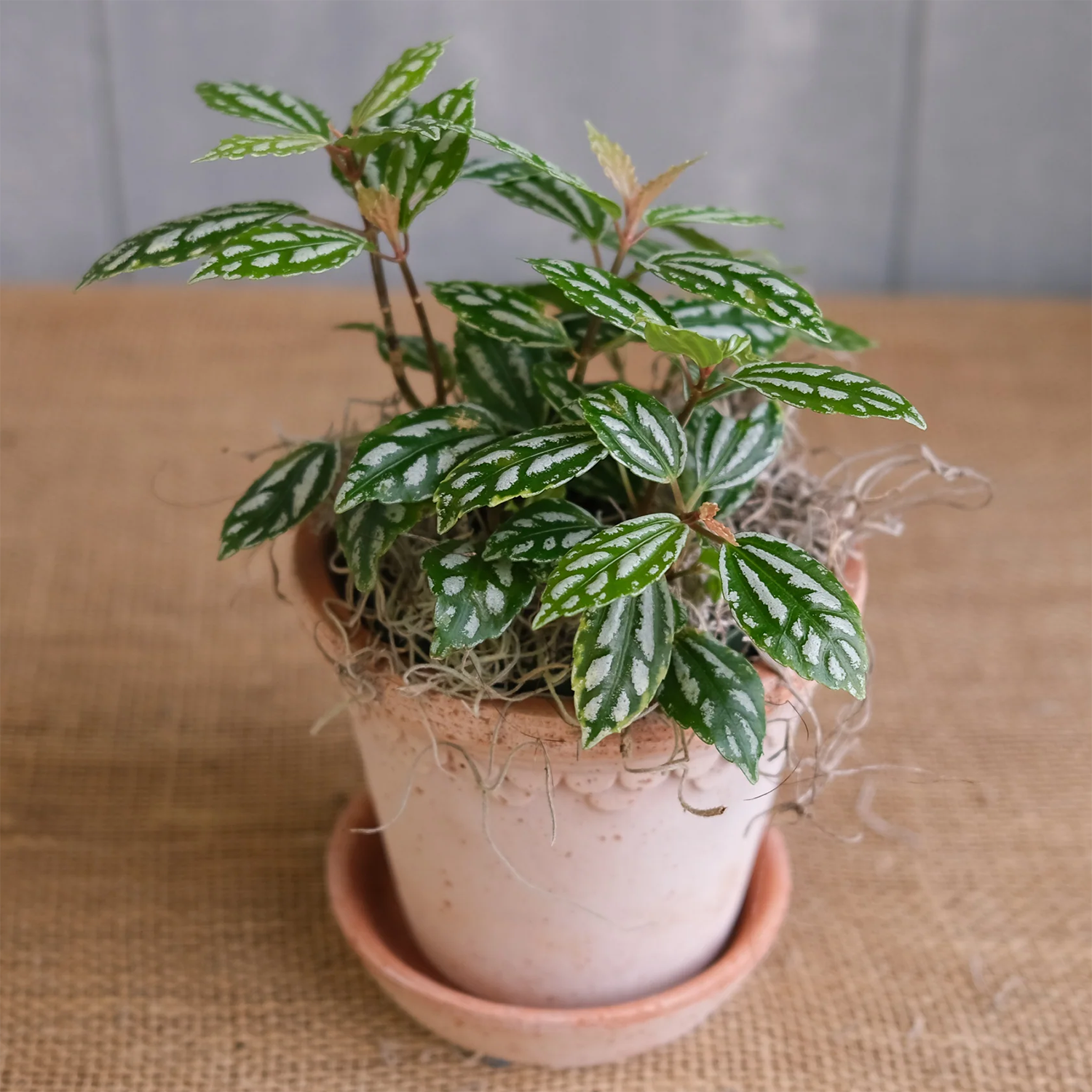
Aluminum Plant
Pilea cadierei
Size: Small, up to 12″.
Light: Bright, filtered light. Tolerates lower light, but will lose variegation if light level is too low.
Water: Keep soil lightly moist while actively growing. Slightly drier in winter. Over-watering will cause leaves to wilt or fall.
Humidity: Moderate to high humidity. Loves to be misted.
Great pick for a terrarium.
-
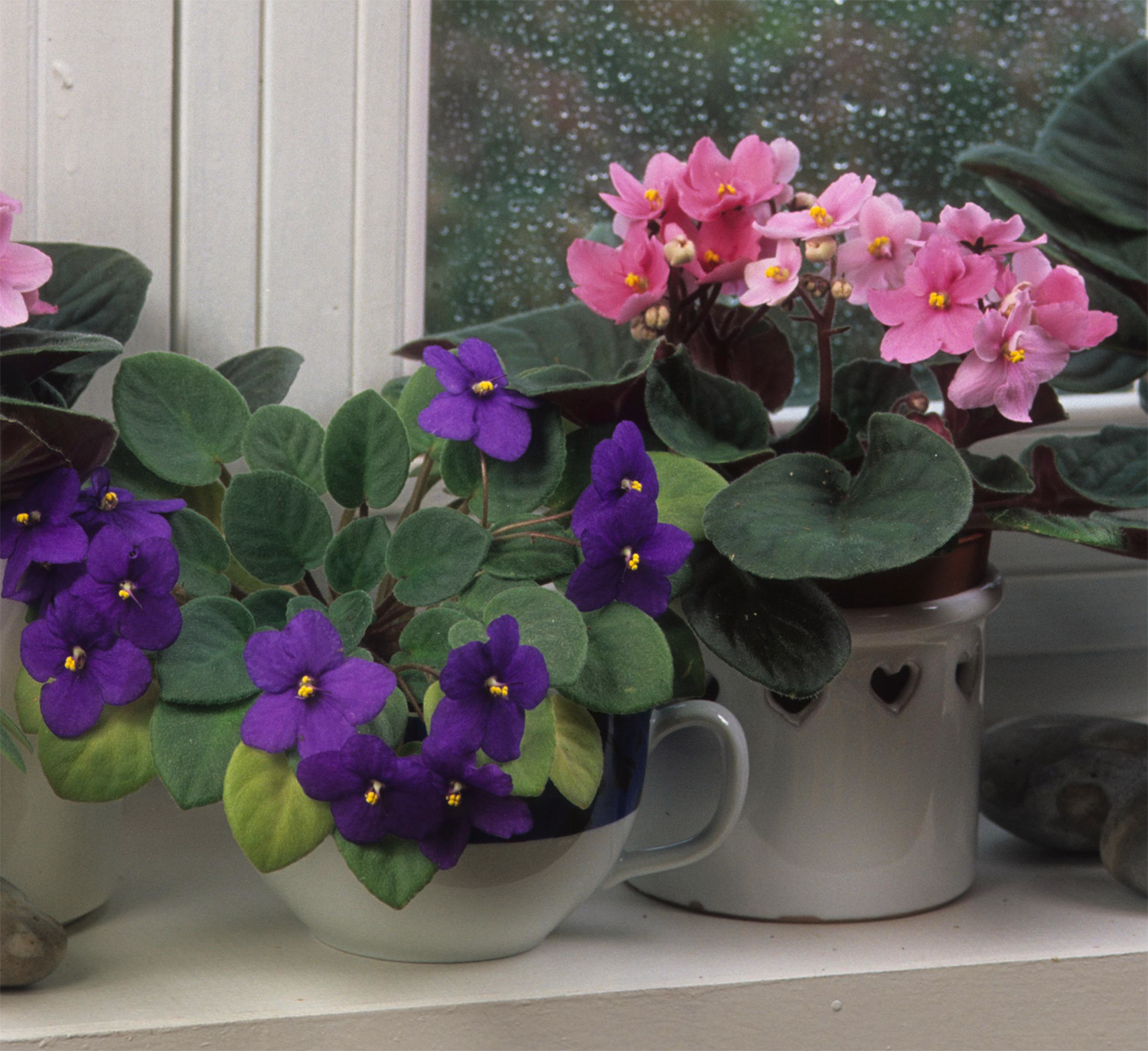
African Violet
Information SheetSaintpaulia
Size: Small, up to 6″ tall.
Light: Medium to high light, but summer sun will scorch the leaves. Needs bright light for blooms.
Water: Keep soil moist, but not soggy. Performs best from bottom watering.
Humidity: Moderate to high humidity. Set plant on tray of wet pebbles to raise humidity, does not like to be misted.
Can bloom all year. Deadhead spent flowers to encourage more blooming.
-
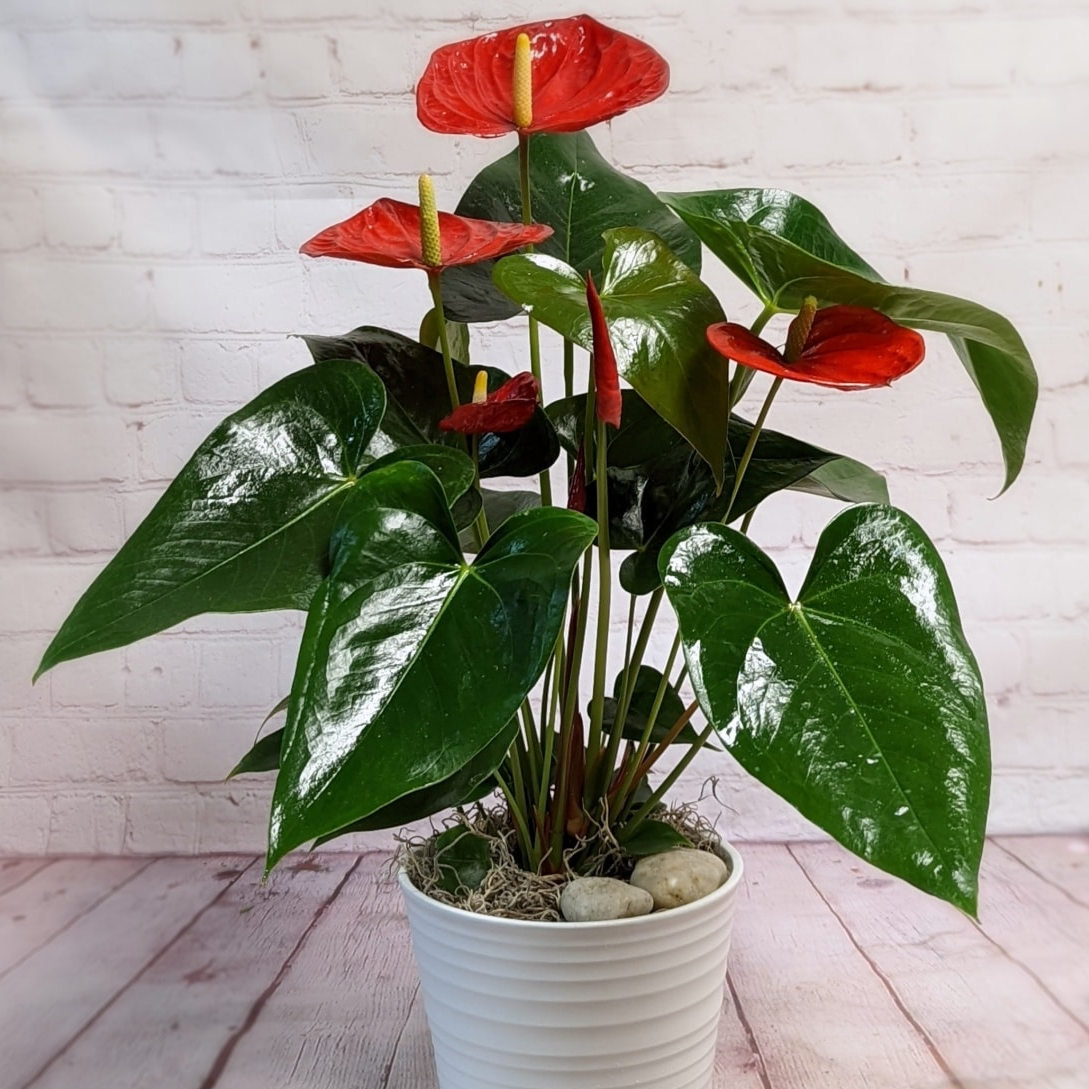
Anthurium
Information SheetAnthurium
Size: Medium, up to 18″
Light: Grows in medium to high light. Encourage more blooms with brighter light, but not direct sunlight.
Water: Keep evenly moist while actively growing, slightly drier in the winter. Over-watering causes yellowing.
Humidity: Prefers high humidity. Brown leaf tips are a sign the air is too dry.
Keep those leaves nice and glossy by wiping them with a damp cloth.
-
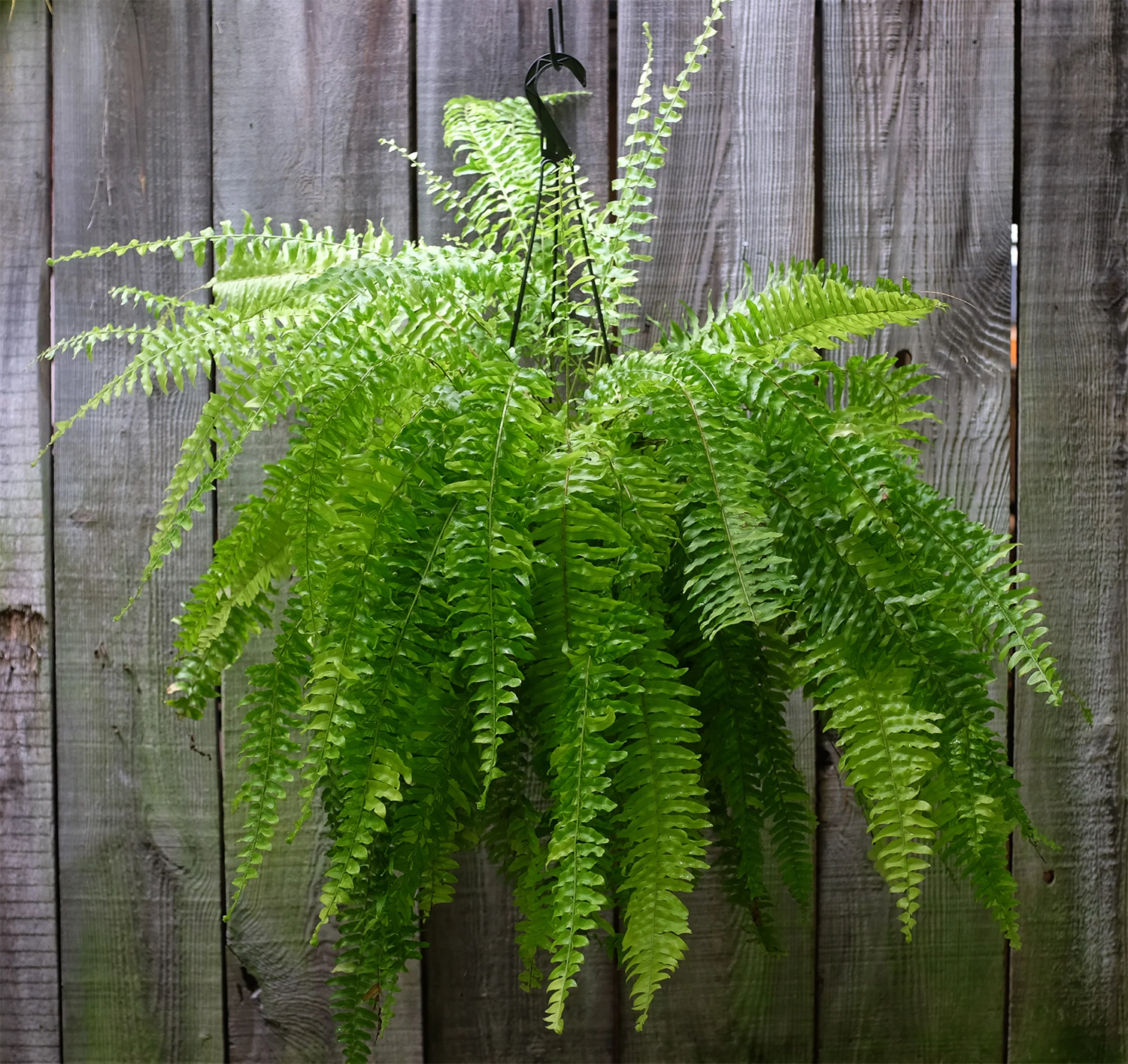
Boston Fern
Nephrolepsis exaltata
Size: Small to medium typically 1-3′ tall.
Light: Moderate to bright light, but no direct sun. Benefits from occasional turning.
Water: Keep soil evenly moist but not soggy. Potting medium tend to dry out quickly with Boston ferns.
Humidity: Prefers high humidity. Mist regularly.
Great selection for a hanging pot.
-
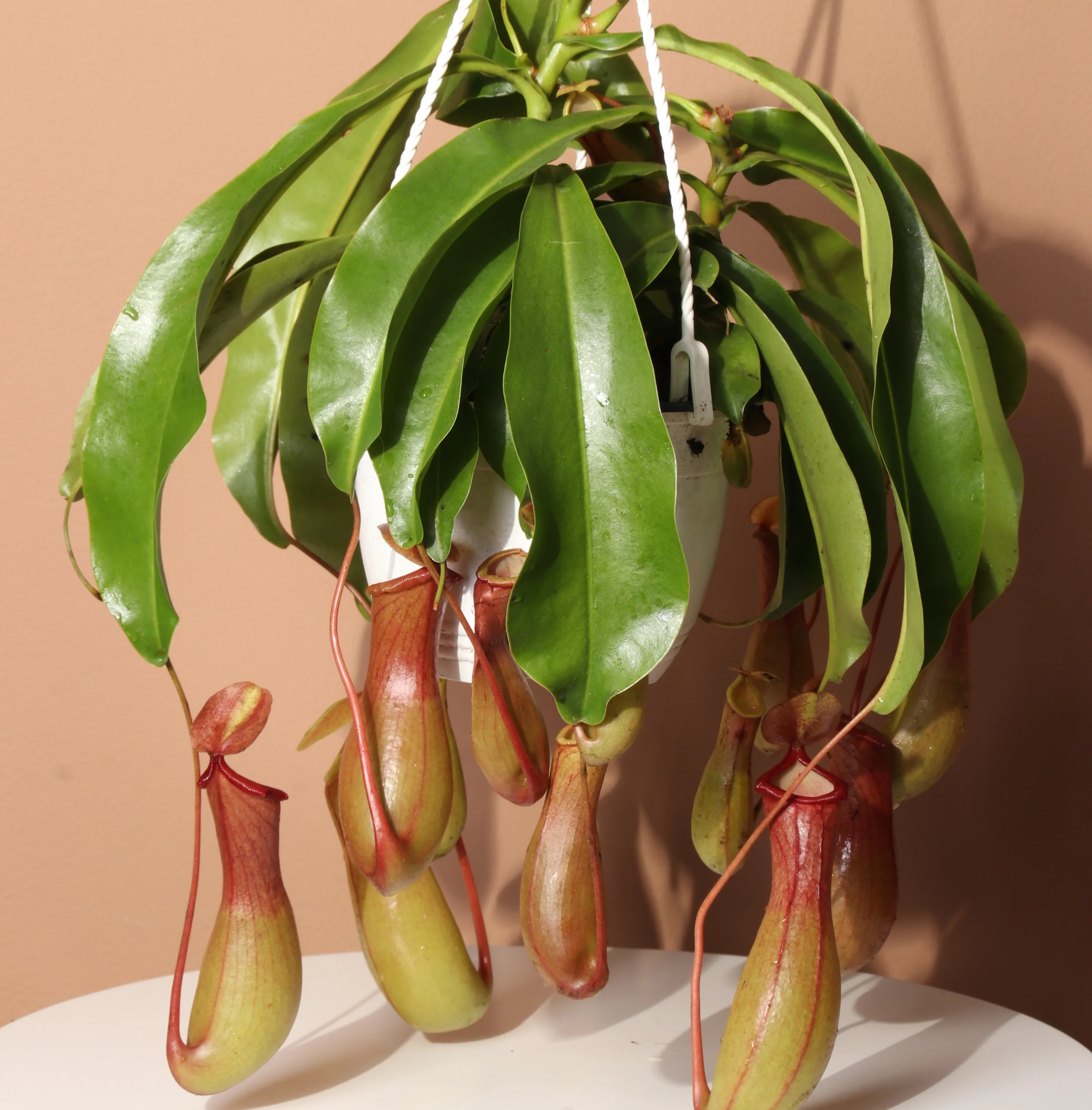
Carnivorous Pitcher Plant
Information SheetNepenthes
Size: Medium, up to 20".
Light: Partial sunlight.
Water: They need constant moisture to thrive with an occasional flooding to wash away any accumulated salt buildup around the roots of the plant.
Humidity: They prefer about 50% humidity.
Eating bugs is nutritious.
-
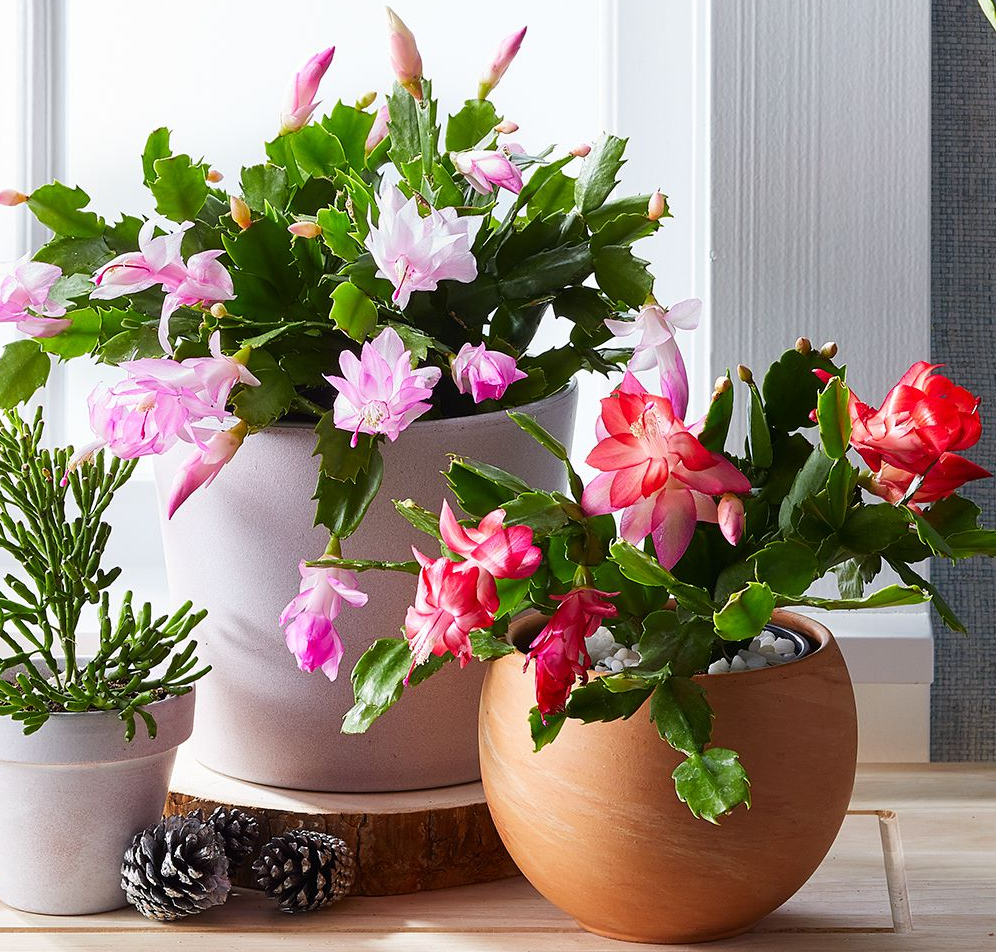
Christmas Cactus
Information SheetSchlumbergera bridgesii
Size: Medium, up to 2′ tall.
Light: Bright, indirect light. Tolerates lower light but flower buds may drop or never form if too low.
Water: Keep soil moist, but not soggy while actively growing. Water sparingly in the winter.
Humidity: Average household humidity. Place on a tray of wet pebbles to raise humidity if needs be.
Prefers to be slightly pot-bound and blooms better this way.
-
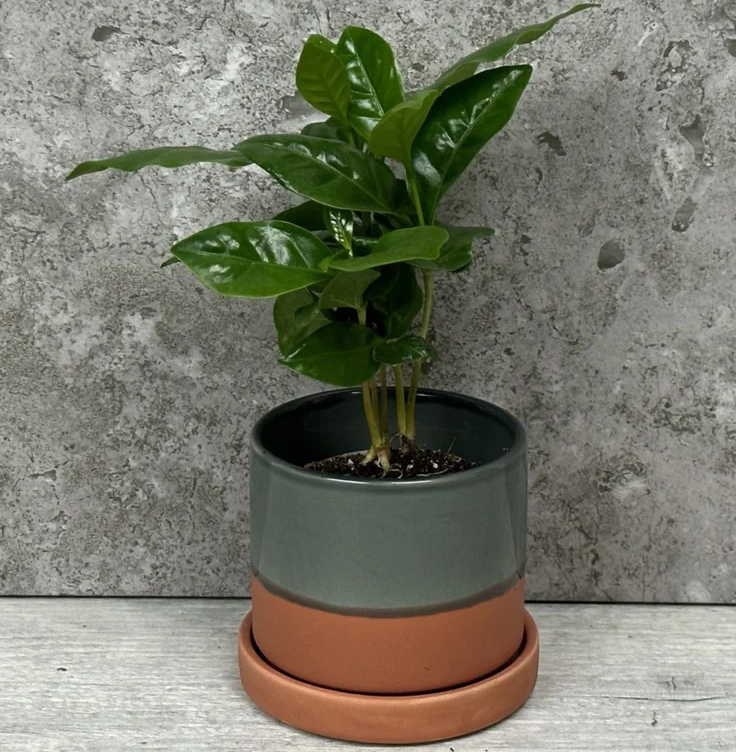
Coffee Plant
Information SheetCoffea Arabica
Size: Large, up to 15', but can be kept smaller with regular trimming.
Light: Filtered, bright light to part shade.
Water: Prefers evenly moist soil, but not soggy. Do not let the soil dry out too much.
Humidity: Moderate to high humidity. Using a plant tray with wet pebbles helps.
-
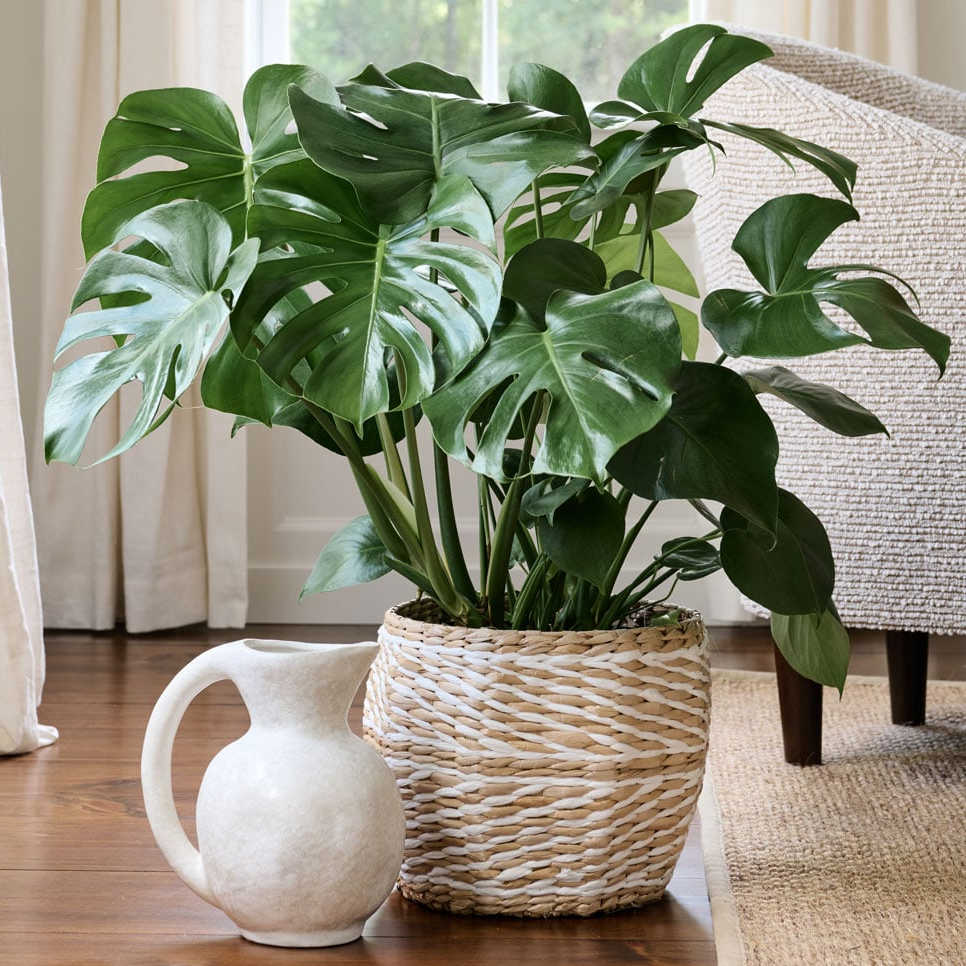
Cut-Leaf Philodendron
Monstera deliciosa
Size: Large, up to 10′ tall.
Light: Medium to high light, but no direct sun. Increase light to encourage slits in mature leaves.
Water: Allow top 1″ of soil to dry out before watering. Keep soil barely moist in winter. Yellowing is typically a sign of over-watering.
Humidity: Average to high humidity.
Lush, dramatic specimen pick.
-
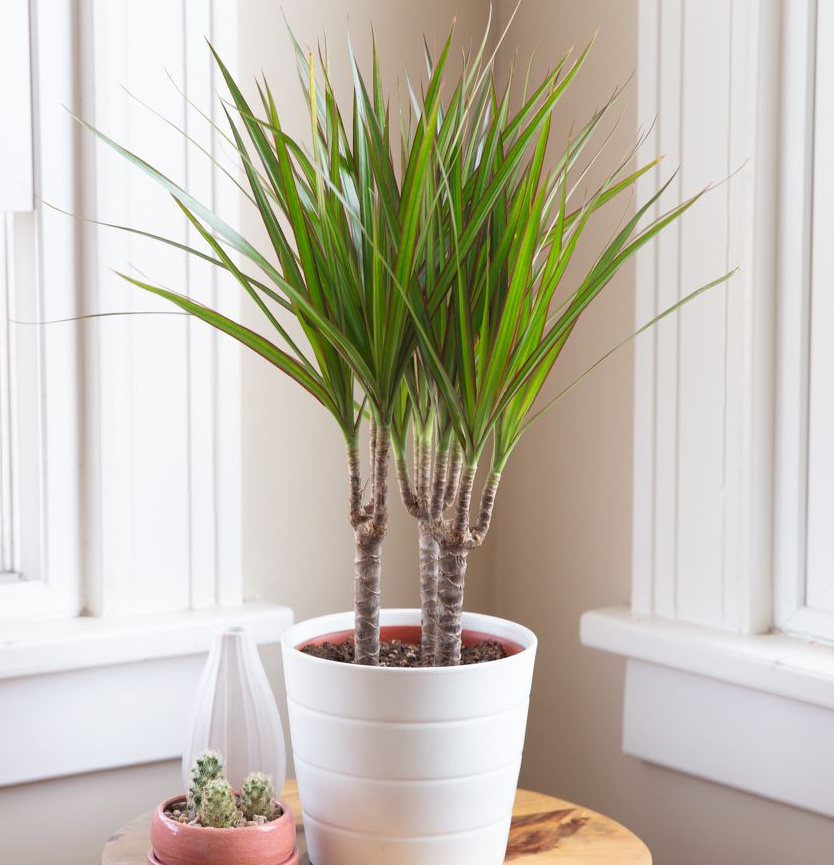
Dragon Tree
Dracaena marginata
Size: Large, up to 6′ tall
Light: Grows in medium to high light. Avoid direct sun. Appreciate being turned to expose all sides to light.
Water: Keep slightly moist during growing season. Slightly drier in winter months. Root rots easily from over-watering.
Humidity: Average household humidity.
Very adaptable plant, just do not over-water.
-
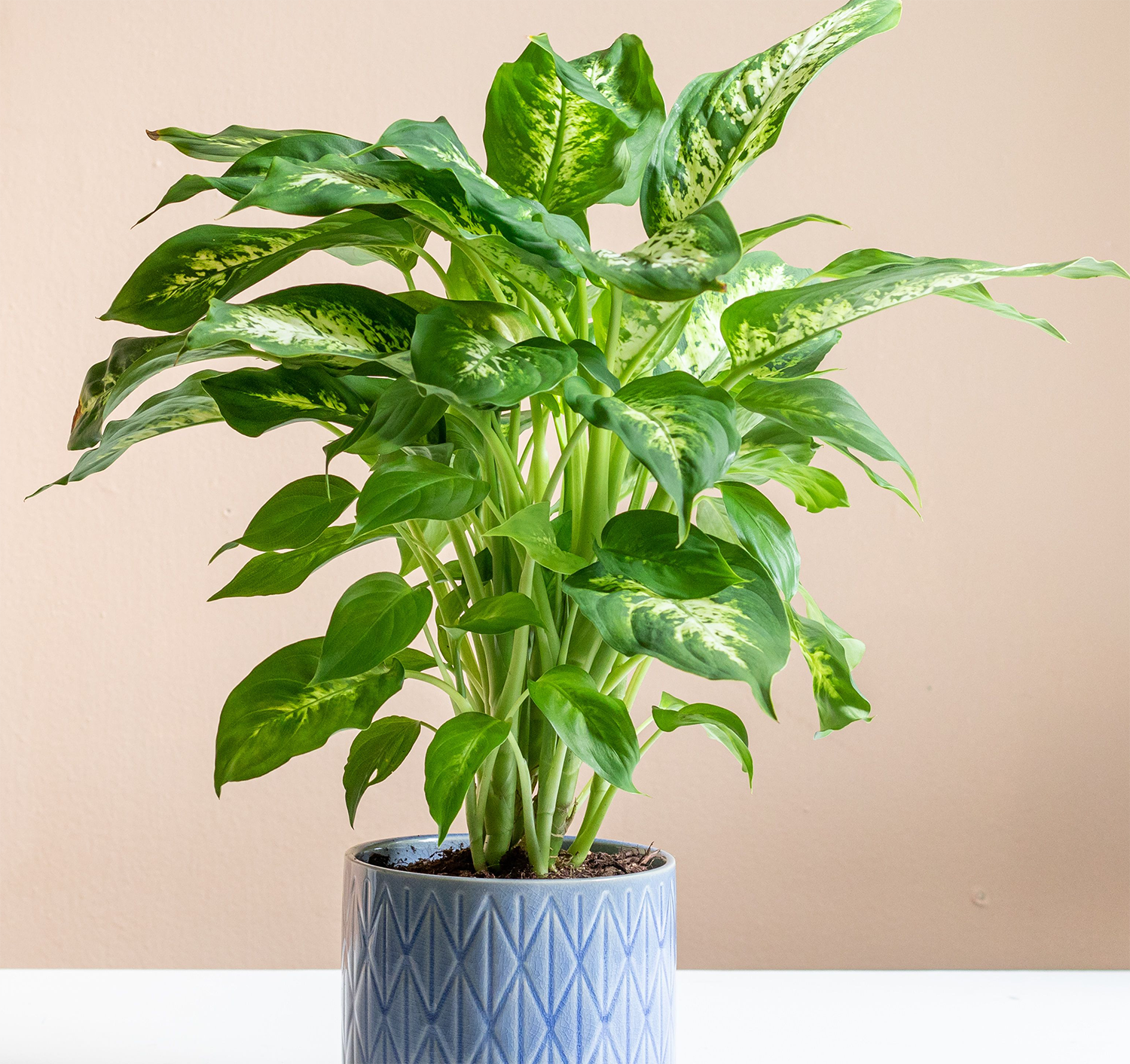
Dumb Cane
Dieffenbachia x
Size: Medium to large, 1-6′ tall.
Light: Grows in medium to bright light. Leaf variegation can fade if light is too low.
Water: Allow soil to dry our a bit before watering. Leaves droop when it needs water.
Humidity: Prefers high humidity but will tolerate basic household humidity.
Older leaves may turn yellow and drop. This is normal.
-
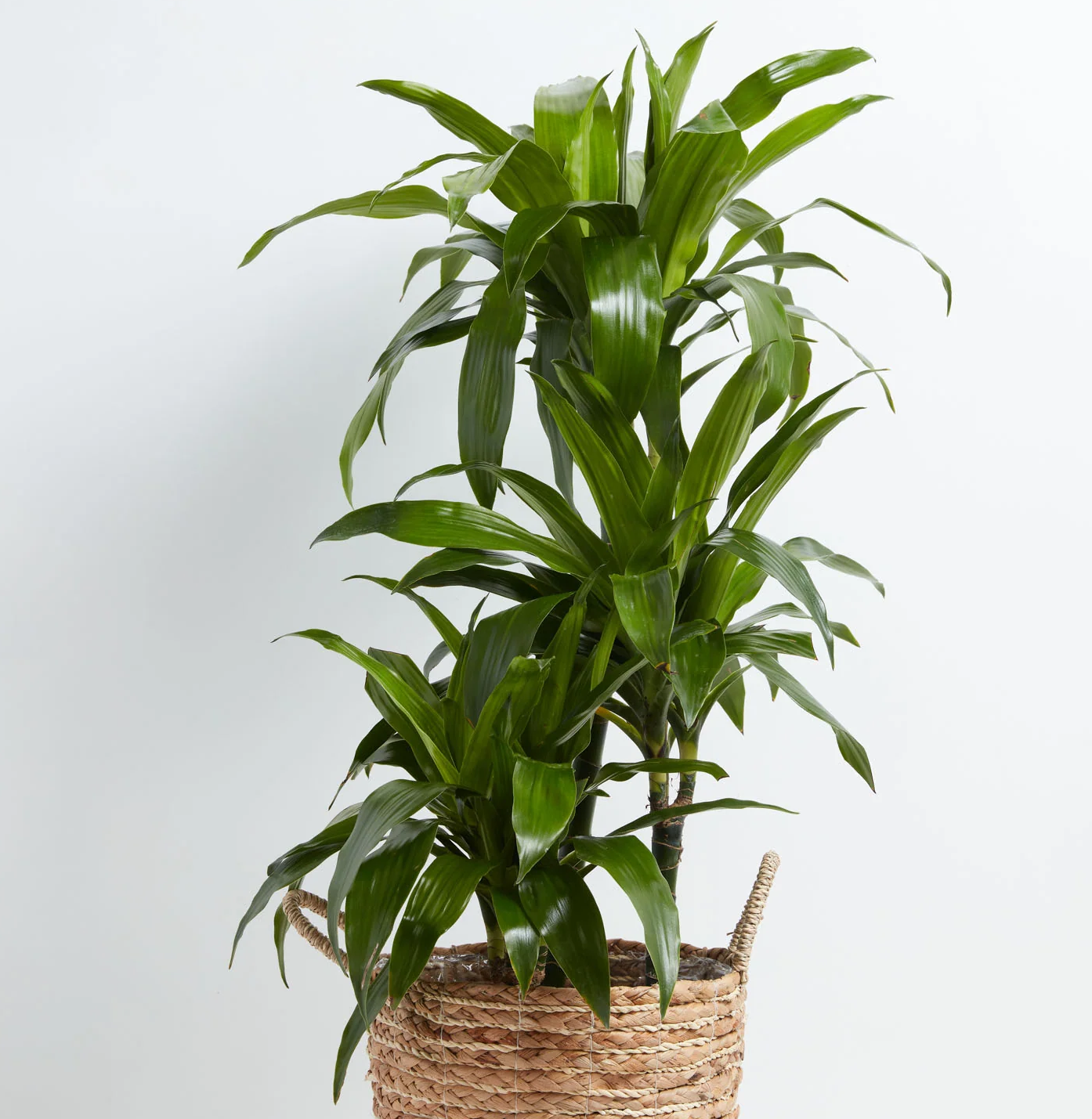
Janet Craig Dracaena
Dracaena dermensis
Size: Large, up to 10′.
Light: Grows in medium to bright light, but not direct sunlight. Pale leaves can indicate light is too low.
Water: Allow top inch of soil to dry out before watering. Does not tolerate soggy soil.
Humidity: Will tolerate basic household humidity.
Often mistaken for Dracaena compacta, which only grows to 2′, be sure to check cultivar.
-
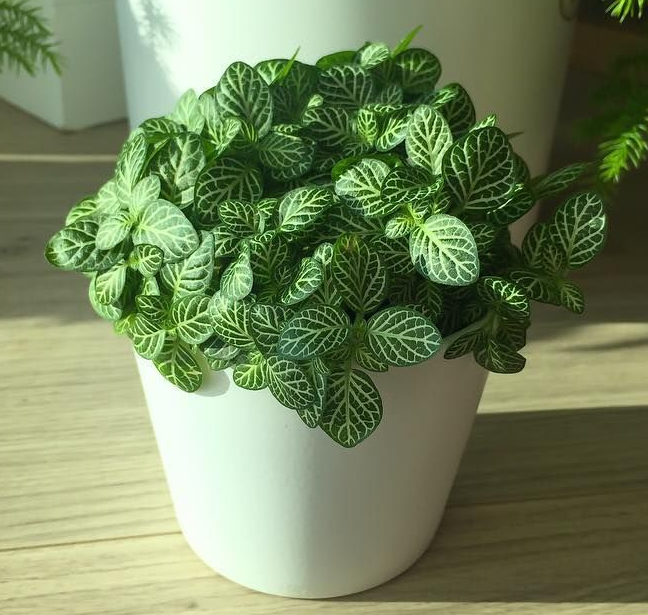
Nerve Plant
Fittonia verschaffeltii
Size: Small, up to 6″.
Light: Grows in low to medium light. Avoid direct sun. Can be grown under fluorescent light.
Water: Keep soil constantly moist, but never soggy. Plant into well draining soil
Humidity: Needs high humidity, leaves will shrivel if air is too dry.
Great selection for a terrarium.
-
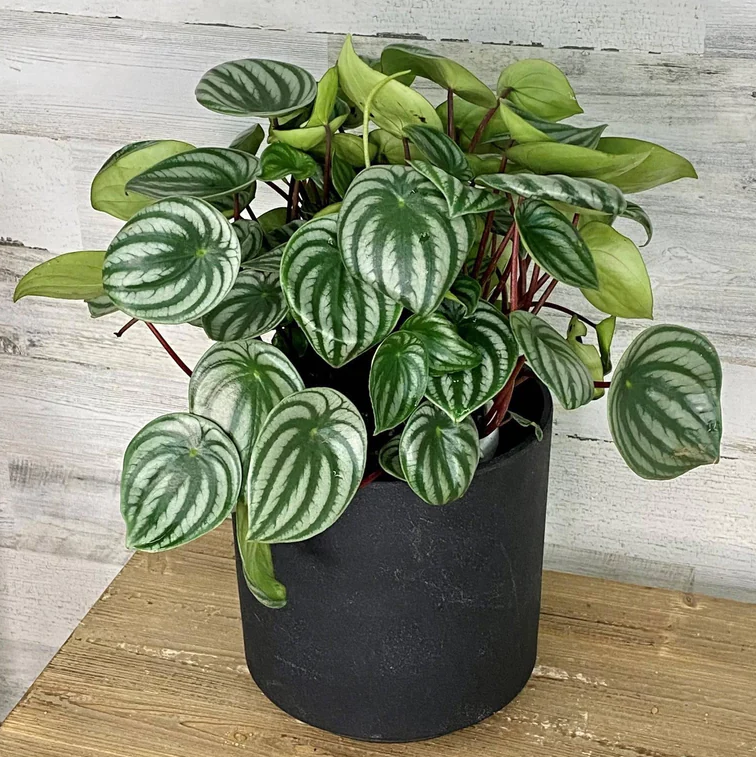
Peperomia
Peperomia caperata
Size: Small, up to 8″ tall.
Light: Grows in low to bright light, but not direct sun. Thrives under grow lights.
Water: Allow top inch of soil to dry out before watering. Keep soil barely moist, less in winter.
Humidity: Tolerate basic household to high humidity.
Great selection for an office plant or terrarium.
-
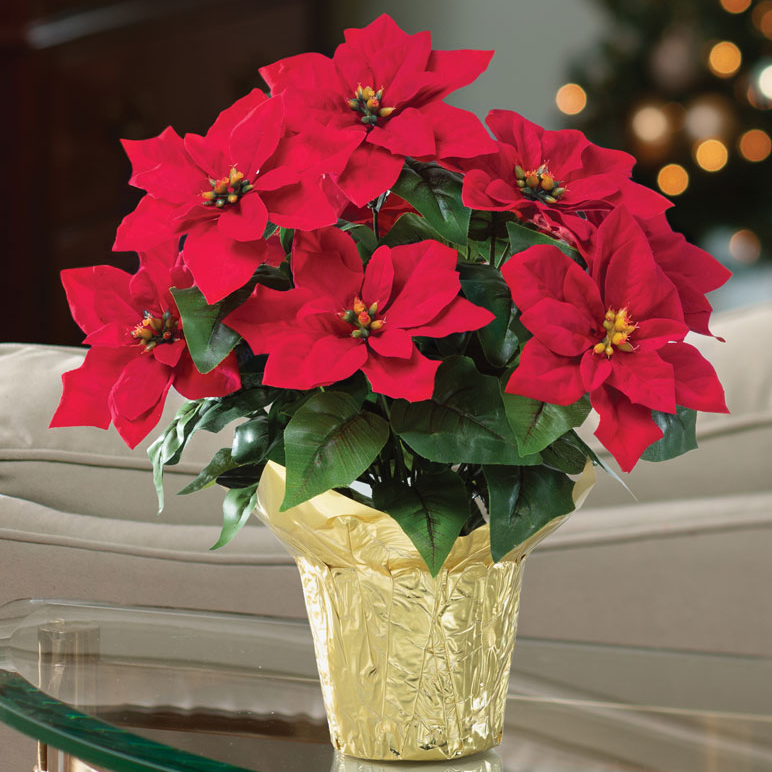
Poinsettia
Information SheetEuphorbia pulcherrima
Size: Large, up to 12' tall.
Light: Bright indirect light.
Water: Prefers to be evenly moist.
Humidity: Meh.
There is also a common misconception that poinsettias are toxic. The sap is only a mild irritant to both humans and pets.
-
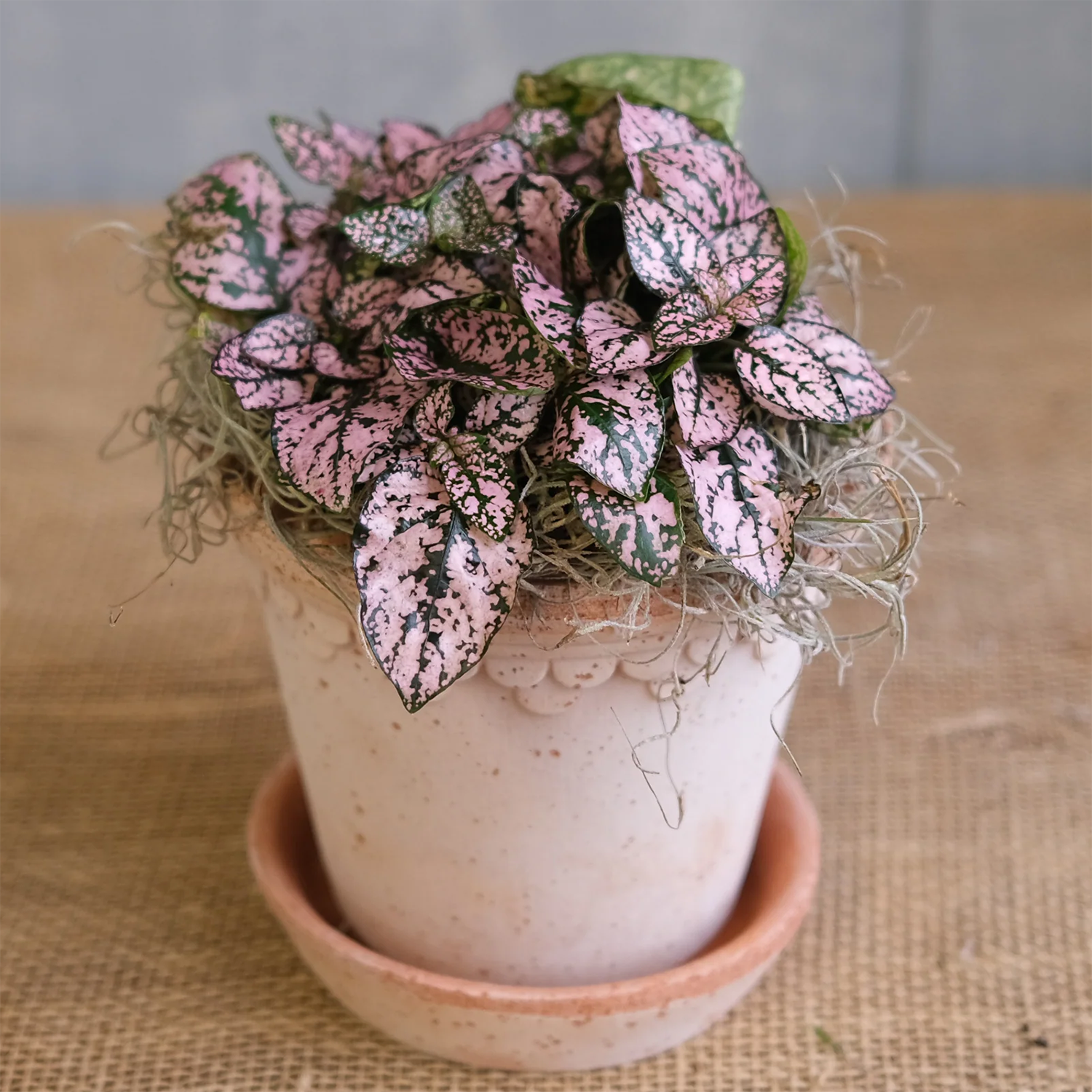
Polka Dot Plant
Hypoestes phyllostachya
Size: Keep around 10″ by pinching to avoid it getting leggy.
Light: Grows in medium to bright, indirect light. Leaf variegation will fade in low light.
Water: Keep evenly moist, slightly drier in winter.
Humidity: Likes moist air, prefers high humidity.
Pinch flower spikes to keep foliage lush and full.
-
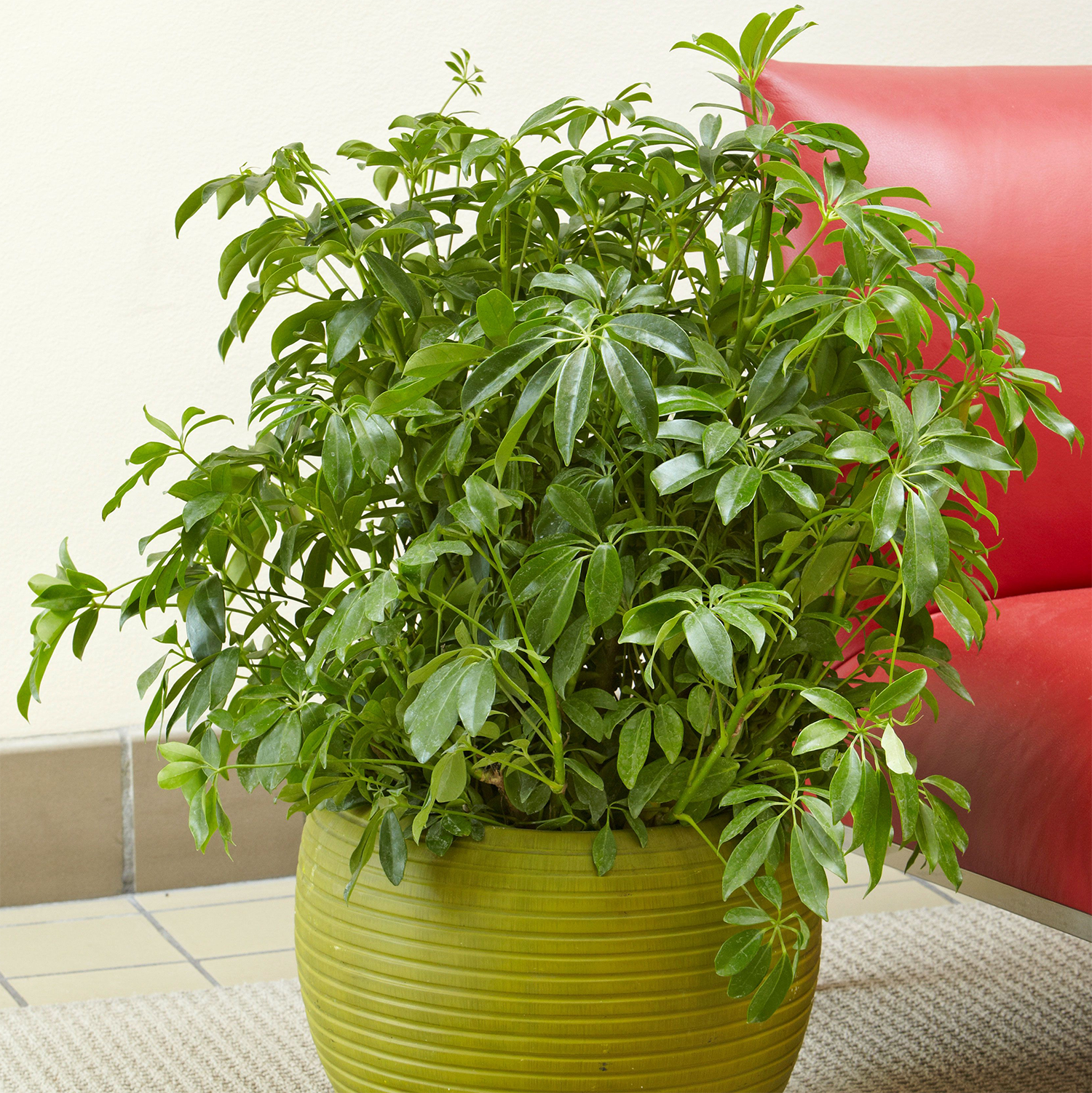
Umbrella Plant
Schefflera actinophylla
Size: Large, up to 6′ tall.
Light: Grows well in medium light but will grow faster and produce more foliage in bright, indirect light.
Water: Allow top inch of soil to dry out before watering. Drooping leaves indicate the soil is too dry.
Humidity: Tolerate basic household humidity.
Easy care plant, but does not respond well to moved.
High Light Houseplants
-
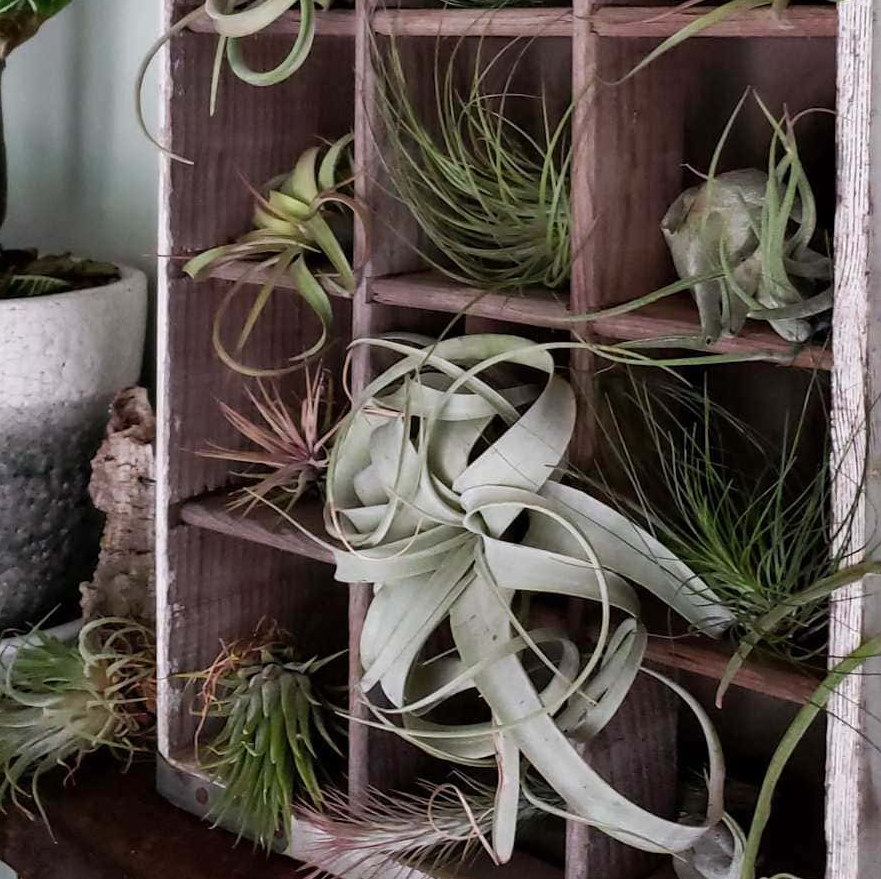
Air Plants
Information SheetTillandsia
Size: Depends on the variety of the species.
Light: Bright, indirect or filtered light is ideal for most tillandsia.
Water: Weekly soakings or baths for 20 minutes to an hour is the best way to keep your air plants well watered.
Humidity: While most like a certain amount of humidity, adequate air circulation is a must for air plants.
Air plants don't need soil, which allows us to display them in more interesting ways than other plants.
-
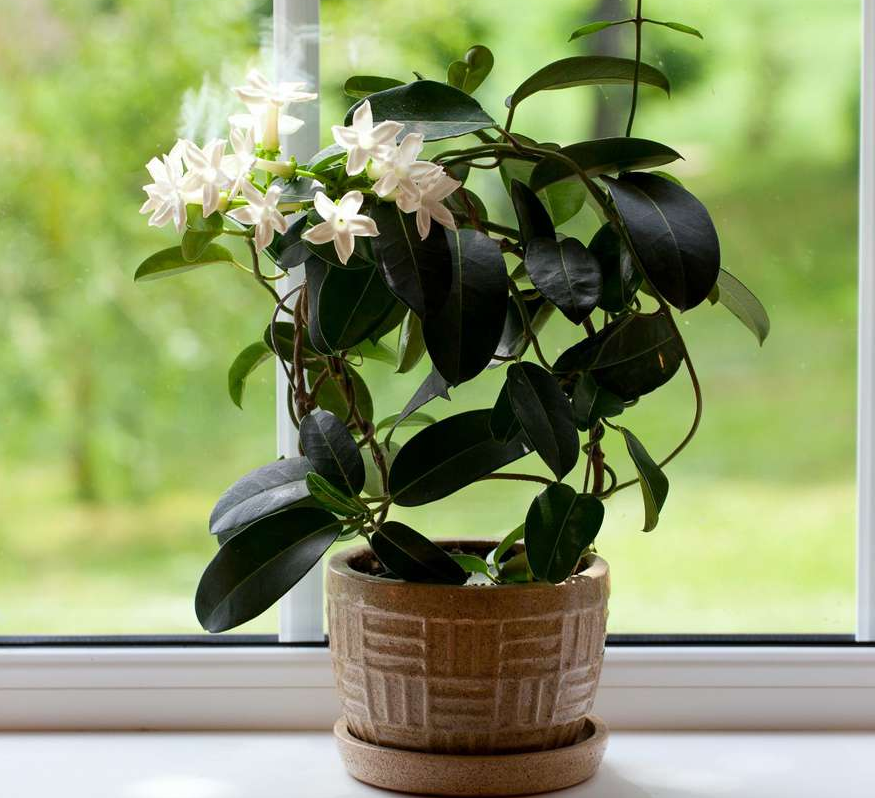
Arabian Jasmine
Information SheetJasminum sambac
Size: Large, up to 10' tall.
Light: Bright light.
Water: They appreciate consistent moisture in well-draining soil. If the top 2" of the soil is dry, it is time to water.
Humidity: Room temperature is okay.
These plants have a sweet, aromatic fragrance and have been used in perfumes and beauty products for centuries.
-
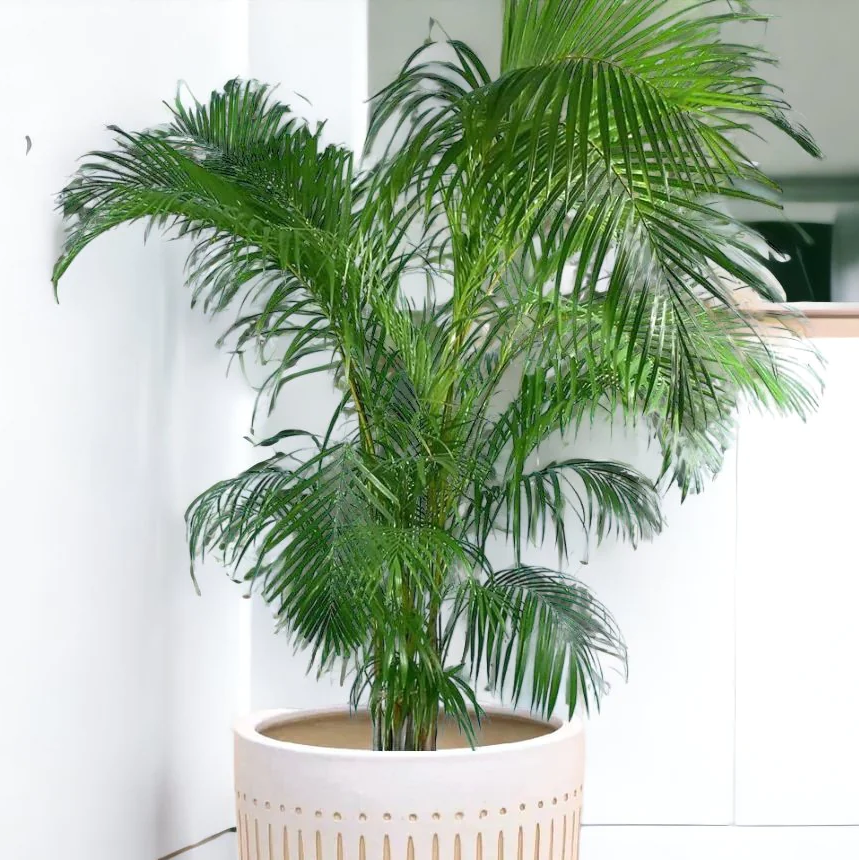
Areca Palm
Dypsis lutescens
Size: Large, slowly growing up to 6-8′ indoors.
Light: Bright, indirect light, but does not like direct sun.
Water: Keep evenly moist. Does not tolerate soggy soil and prefers distilled water.
Humidity: High humidity to keep fronds looking fresh.
Palms like to be a little root-bound, take your time on re-potting.
-
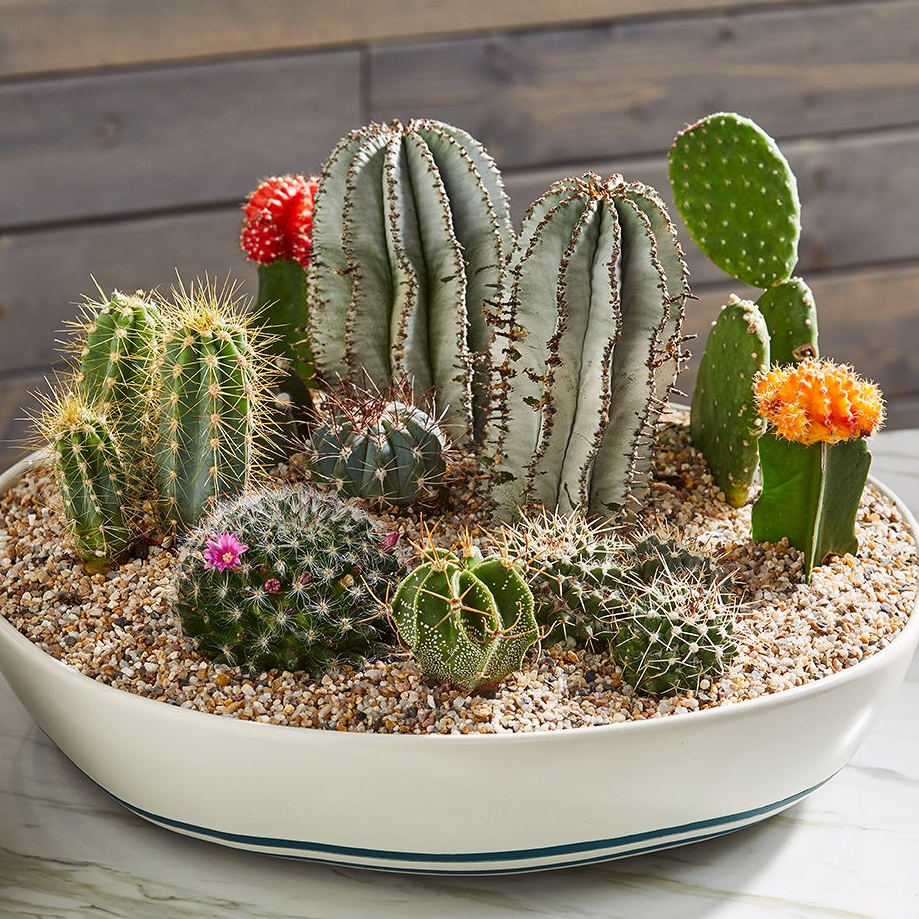
Cactus
Cactaceae Family
Size: Varies by species
Light: High light, at least 2-3 hours of full sun a day.
Water: Water lightly on a regular basis while actively growing, water sparingly in winter. Do not drench soil. Very susceptible to root rot. Prefers distilled water.
Humidity: Average to dry humidity.
Performs best in a cacti potting medium. Typically flowers if given enough light.
-
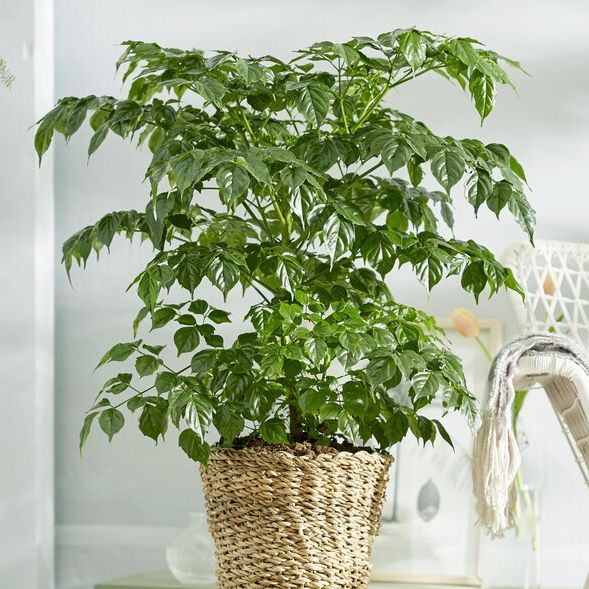
China Doll Plant
Radermachera sinica
Size: Medium, up to 4′ tall indoors.
Light: Bright, indirect light.
Water: Keep soil evenly moist. Do not allow to be soggy or completely dry out. Will drop leaves if too dry. Leaves will yellow and drop if too wet.
Humidity: Average household humidity. Benefits from occasional misting.
Pinch back at leaf node to encourage bushy habit.
-
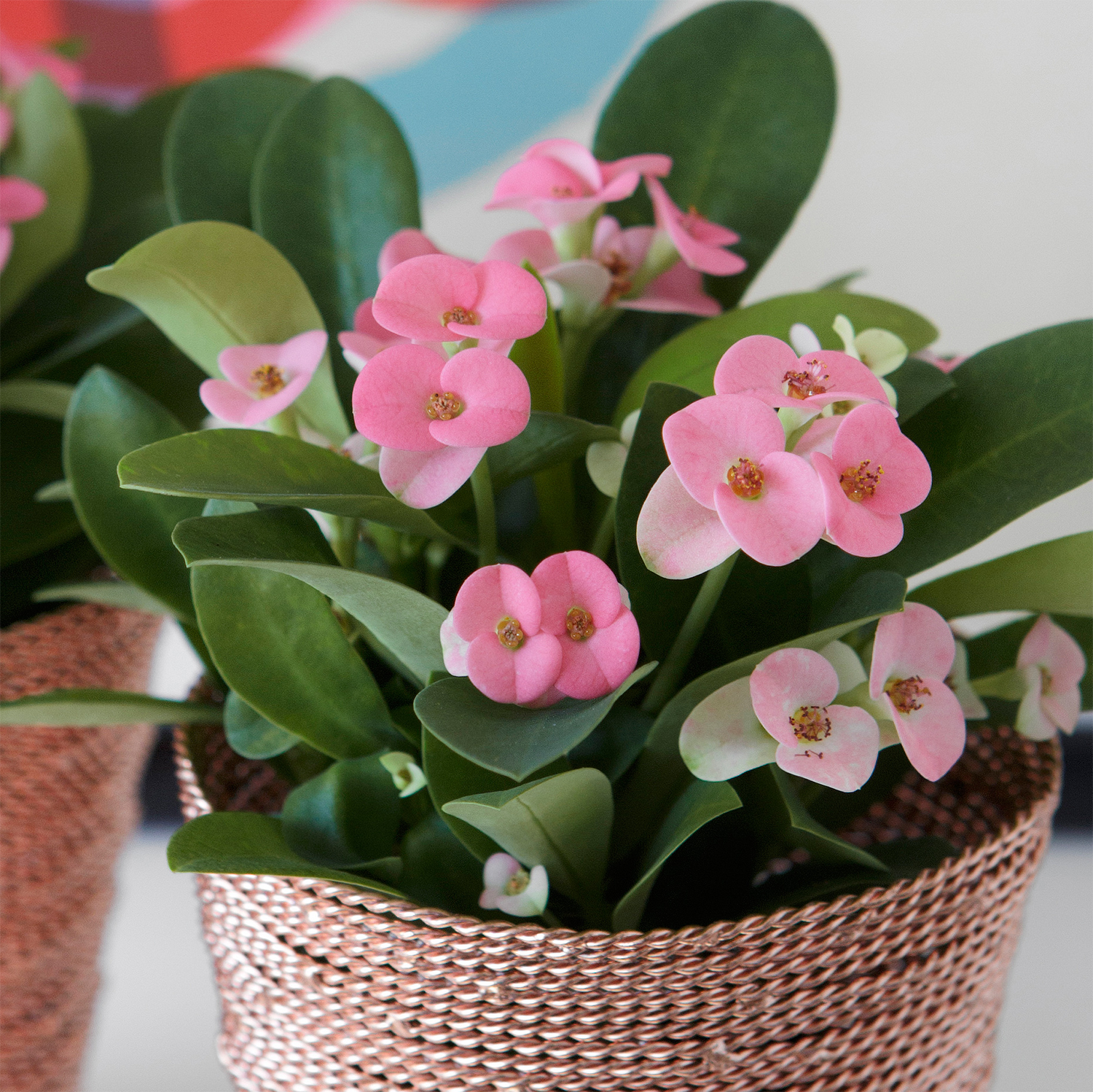
Crown of Thorns
Euphorbia milii
Size: Medium, up to 2′ tall.
Light: Bright light to full sun. Plants not receiving enough lights will not bloom. Prefers about 4 hours of direct sun every day. Rotate to promote even growth.
Water: Allow top 1″ of soil to dry out before watering. Water sparingly in winter. Avoid watering foliage and stems, they can rot easily.
Humidity: Average room humidity.
Performs best in a cacti potting medium. Can bloom almost year-round.
-
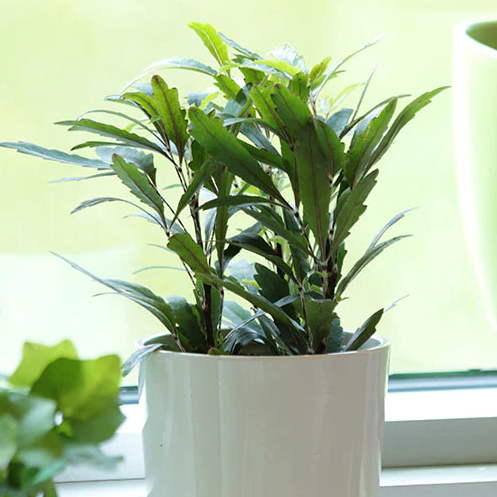
False Aralia
Dizygotheca elegantissima
Size: Large, slowly reaching about 6′ tall indoors.
Light: Bright, indirect light. Keep out of direct sun.
Water: Allow top 1″ of soil to dry out before watering. Wilted leaves are a sign of over-watering.
Humidity: Prefers moderate to high humidity. Try to mist every morning.
Moving to a new location can cause leaf drop.
-
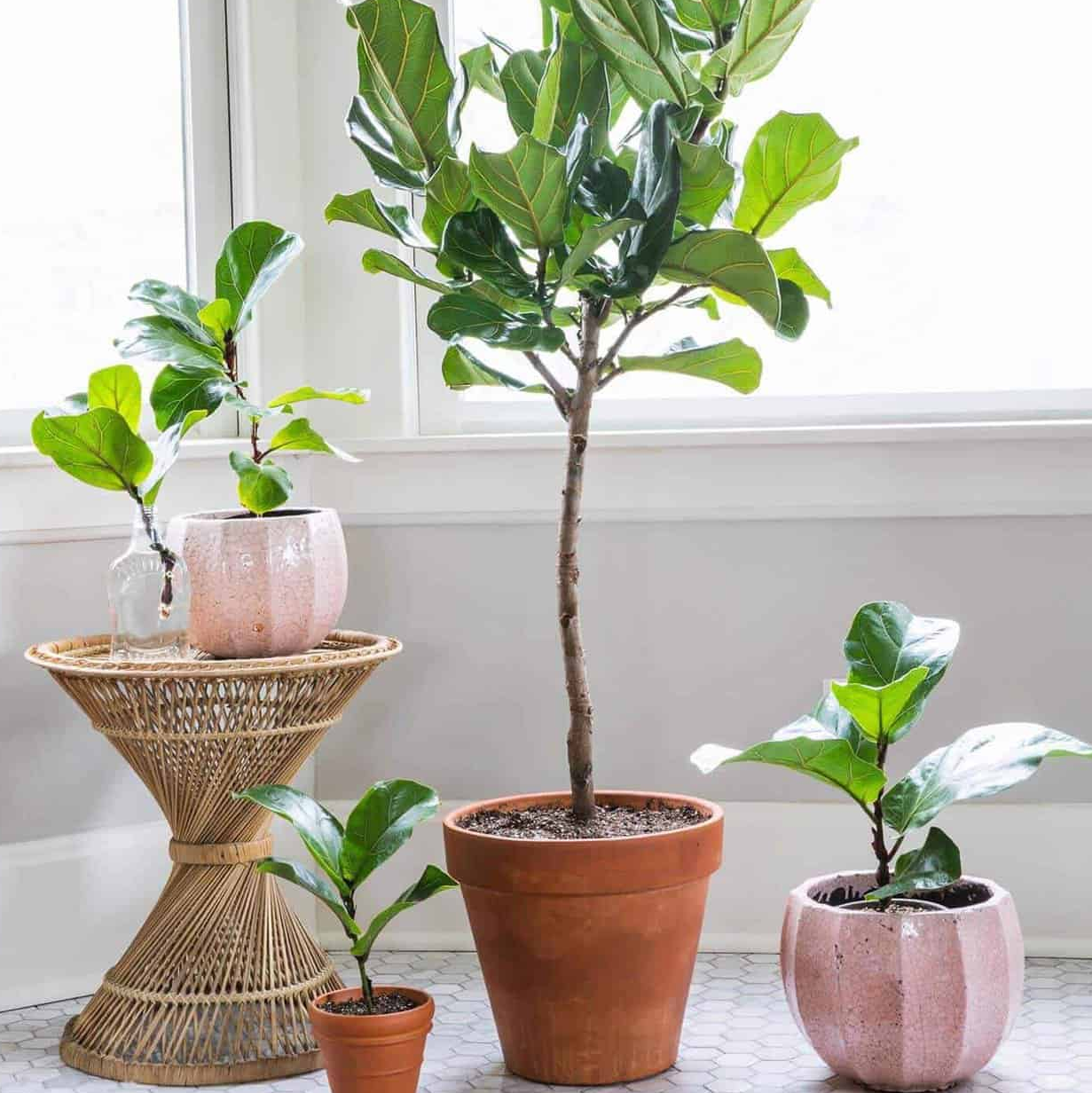
Fiddle Leaf Fig
Ficus lyrata
Size: Large, up to 10′ indoors.
Light: Prefers bright, indirect light. Rotate slightly once a week to keep all sides exposed.
Water: Keep evenly moist. Drooping yellow leaves indicate over-watering.
Humidity: Average room humidity. Brown leaf tips indicate humidity is too low.
Drops leaves easily if moved to new location suddenly.
-
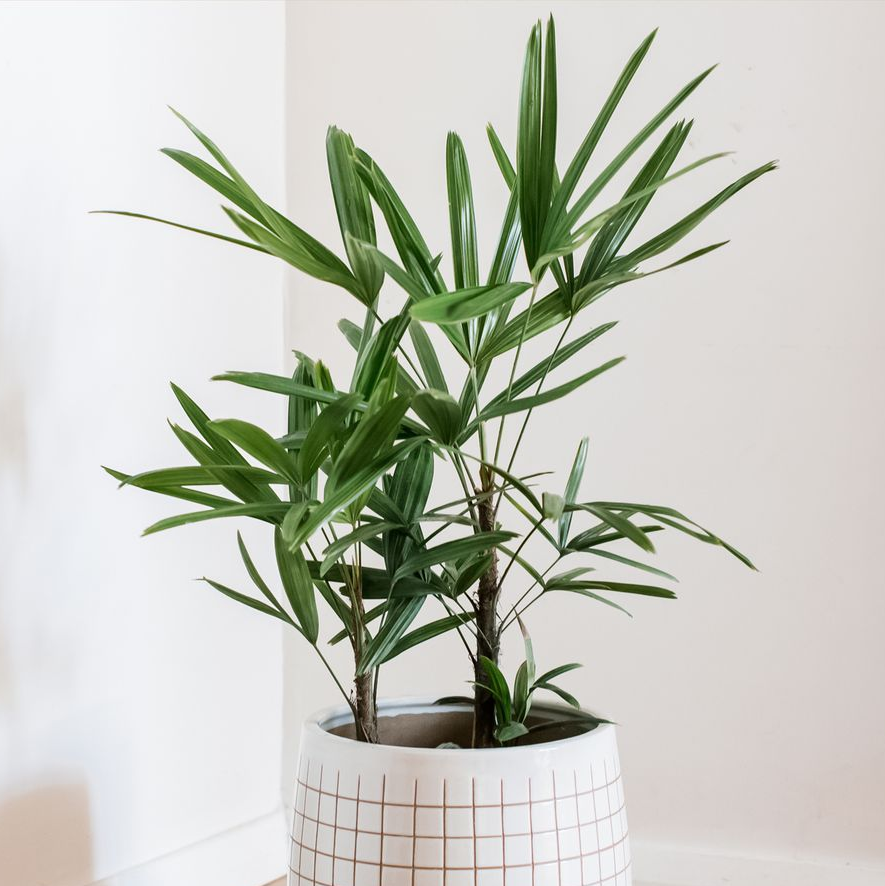
Lady Palm
Rhapis excelsa
Size: Small to large depending on container. Slow growing and will bonsai well, reaching only 12″ high.
Light: Bright, indirect light.
Water: Keep evenly moist during growing season. Allow top 1″ to dry out between watering in winter. Sensitive to treated water. Prefers distilled water.
Humidity: Moderate to high humidity.
Upright growth habit, does not take up a lot of horizontal space.
-
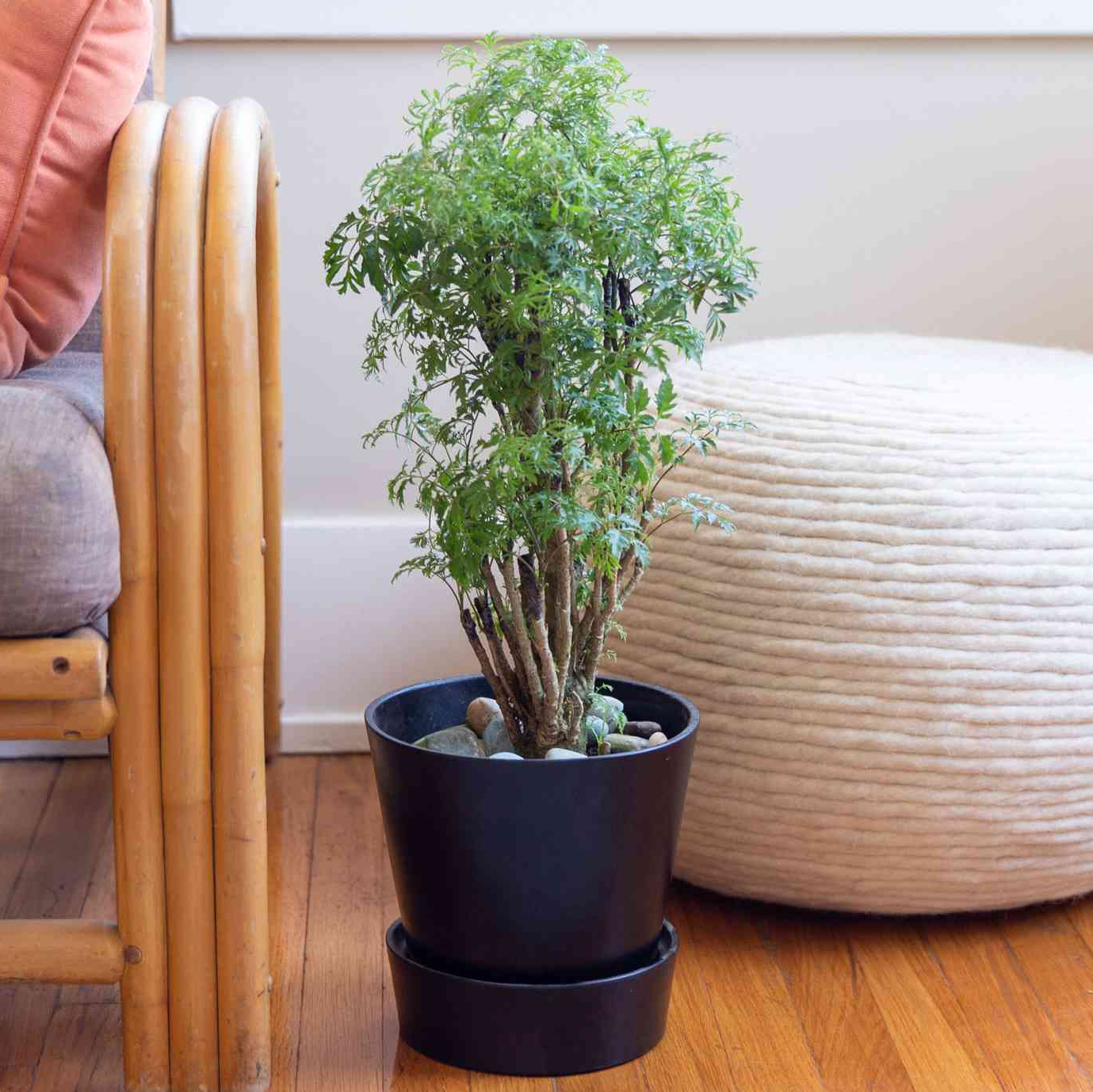
Ming Aralia
Polyscias fruticosa
Size: Medium, up to 3′ tall. Slower growing and can be grown as a bonsai tree.
Light: Prefers bright light, will tolerate low light to full sun.
Water: Allow top 2″ of soil to dry out between watering. Very sensitive to over-watering. Out of caution, it is good to air on the dry side, especially during winter months.
Humidity: Moderate to high humidity. When air is dry, mist every morning.
Over time Ming aralia drops lower leaves, revealing an eye-catching, gnarled tree-like trunk.
-
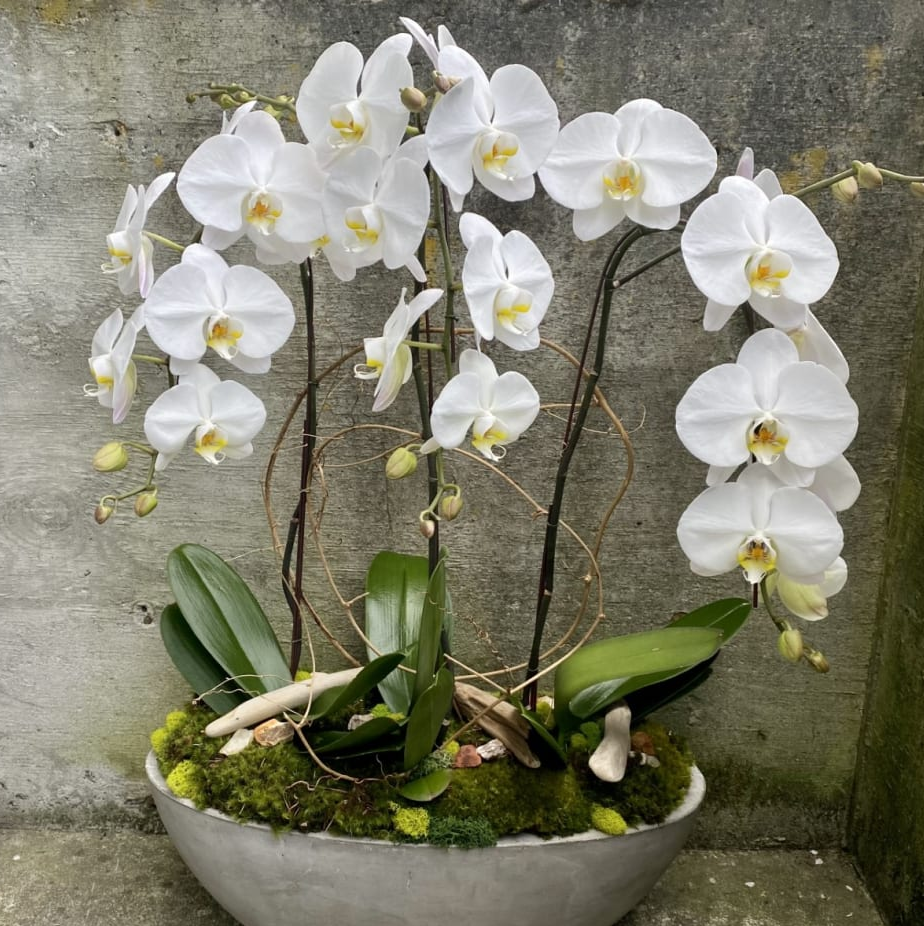
Moth Orchid
Information SheetPhalaenopsis species
Size: Medium, up to 2′.
Light: Best in bright, indirect light, can tolerate medium, but may not bloom. Can be grown under fluorescent lights.
Water: Allow top inch of soil to dry out before watering. Do not let the potting mix get soggy.
Humidity: Prefers high humidity.
Plant in orchid mix, and keep in small pot, prefers to be root bound.
-
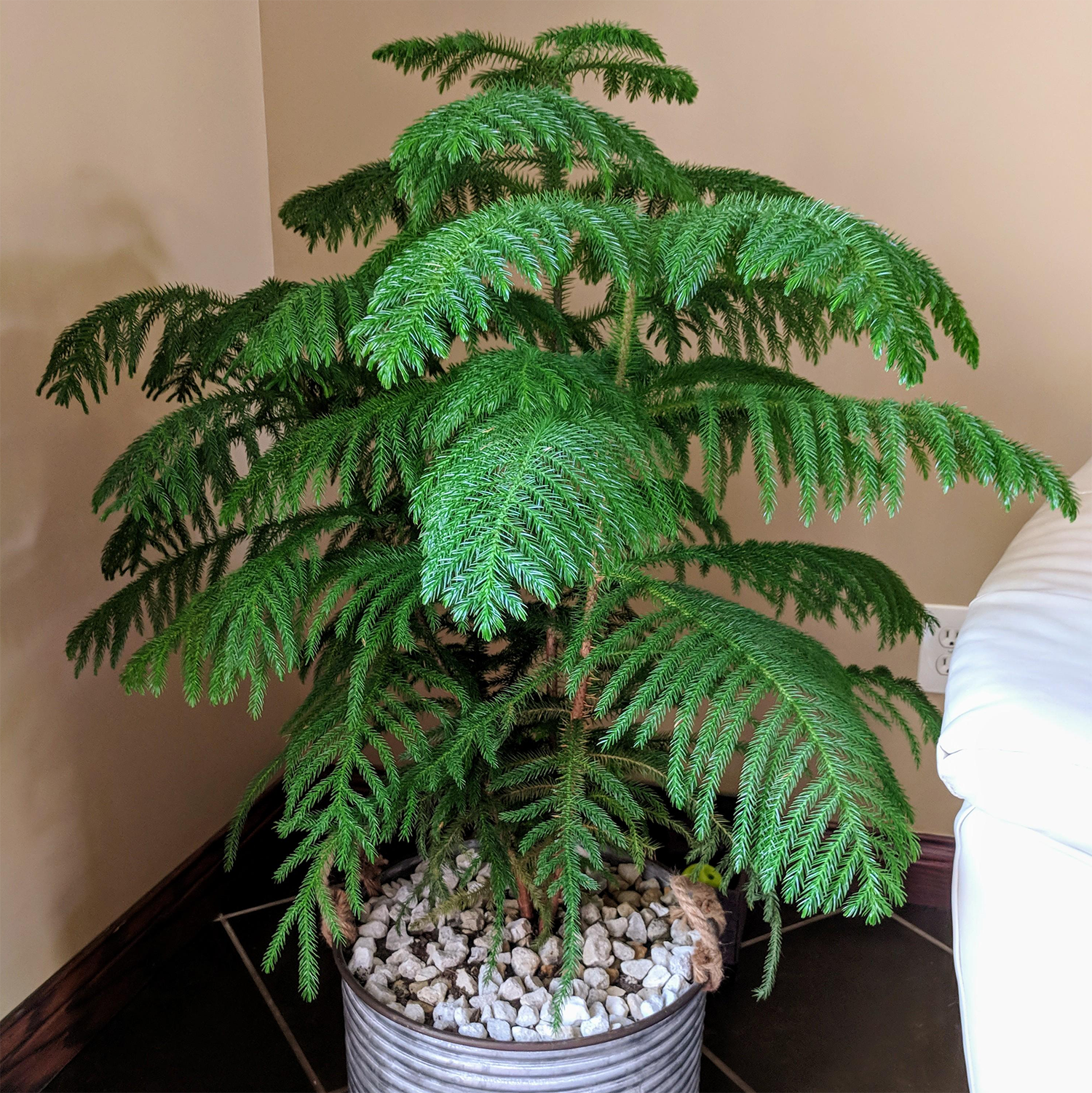
Norfolk Pine
Information SheetAraucaria heterophylla
Size: Large, up to 6′ tall.
Light: Bright light, even some direct sun. Bottom branches will fall off if light is too low.
Water: Keep evenly moist while actively growing. Lightly moist in winter.
Humidity: Tolerate basic household humidity. Dry, yellowing needles can indicate air is too dry.
Does not respond well to pruning
-
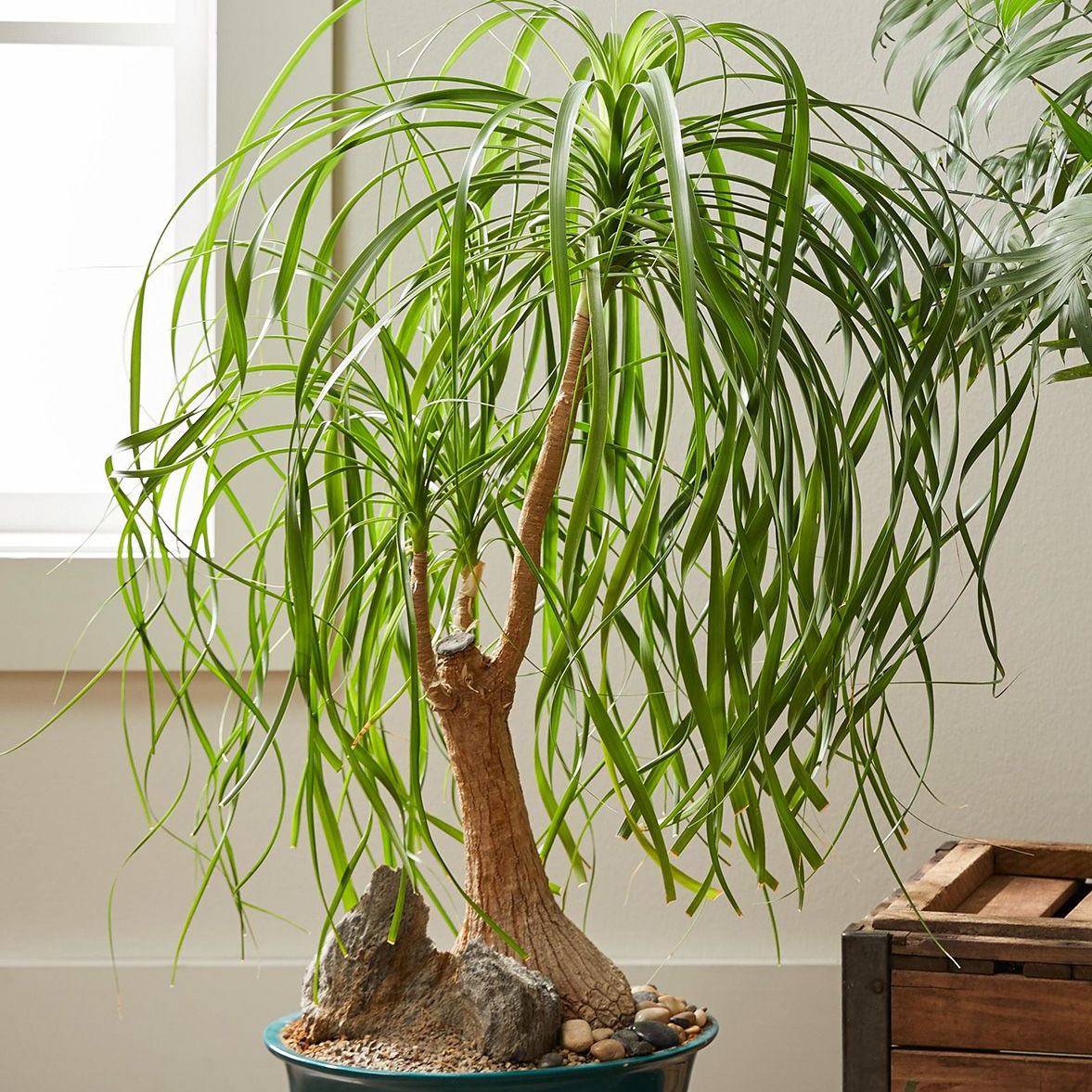
Ponytail Palm
Beaucarnea recurvata
Size: Small to large. Very slow growing to 6′ if given space. Easily grown as a bonsai specimen.
Light: Bright light to full sun.
Water: Allow soil to dry out partially between watering. Water only enough to prevent complete dry out in winter months. Water only the soil, prone to rot if trunk gets wet.
Humidity: Average, but will tolerate dry air.
Quite drought tolerant by storing water in swollen base making them a good choice for the busy or more forgetful plant owners.
-
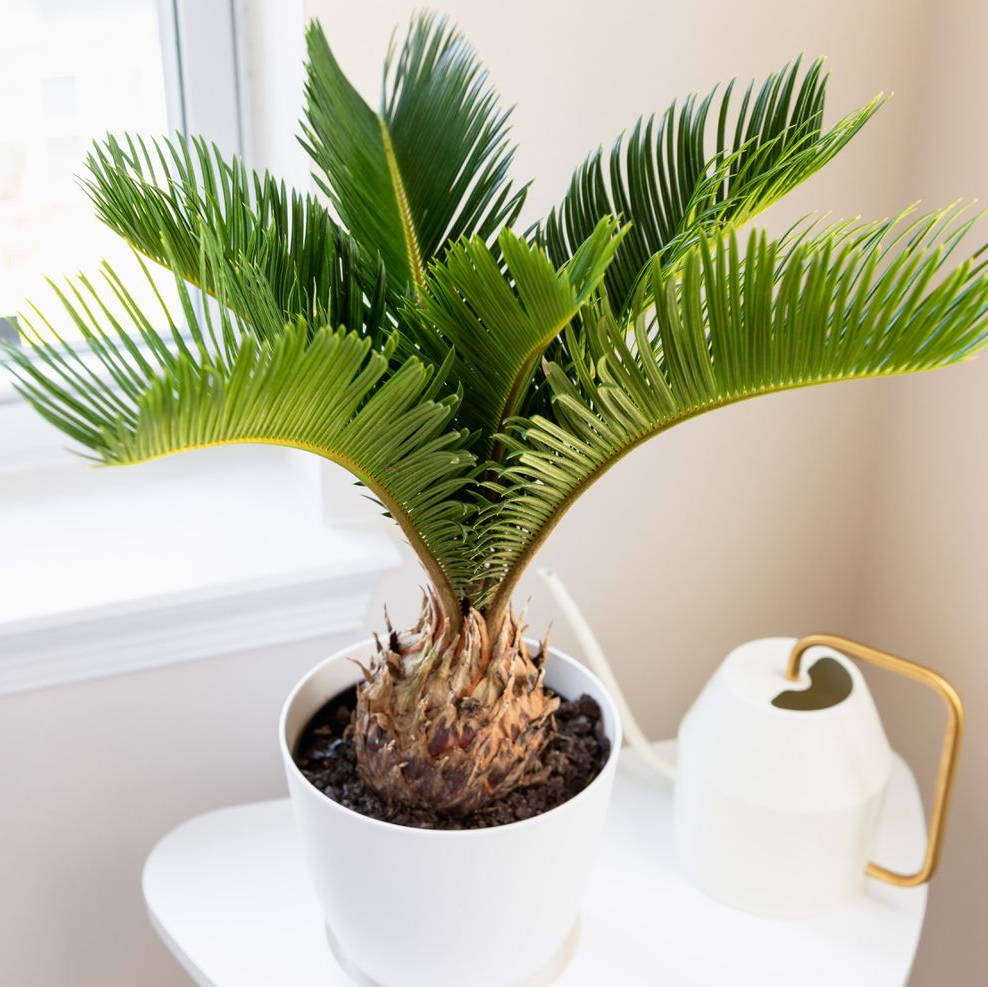
Sago Palm
Cycas revoluta
Size: Small to large depending on container. Extremely slow growing, up to 6′ if allowed.
Light: Bright light with some direct sun. Will lean toward light source if not regularly rotated.
Water: Allow soil to dry out a bit between watering, but not completely. Be careful to water just the soil and not the crown of the plant. Yellow leaves are often caused by over-watering.
Humidity: Average room humidity.
Roots do not like to be disturbed, so repot only when necessary.
-
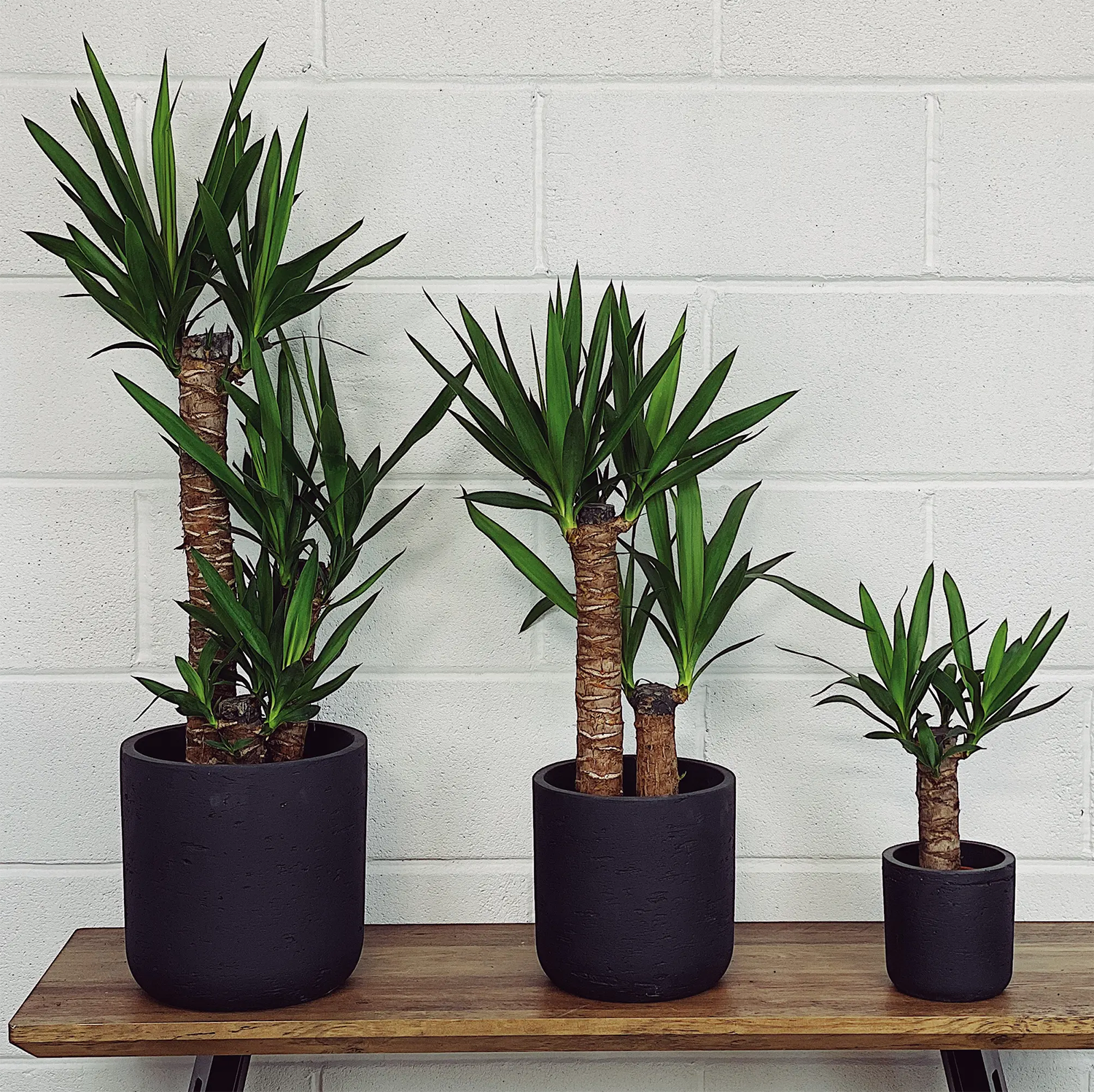
Spineless Yucca
Yucca elephantipes
Size: Medium to large, growing up to 5′ tall.
Light: Prefers bright light, to full sun. Will tolerate lower lights though.
Water: Keep evenly moist during growing season. Water just enough to keep soil from drying completely in winter.
Humidity: Average to dry humidity.
Very adaptable plant and tolerant of changing conditions, except soggy soil.
-
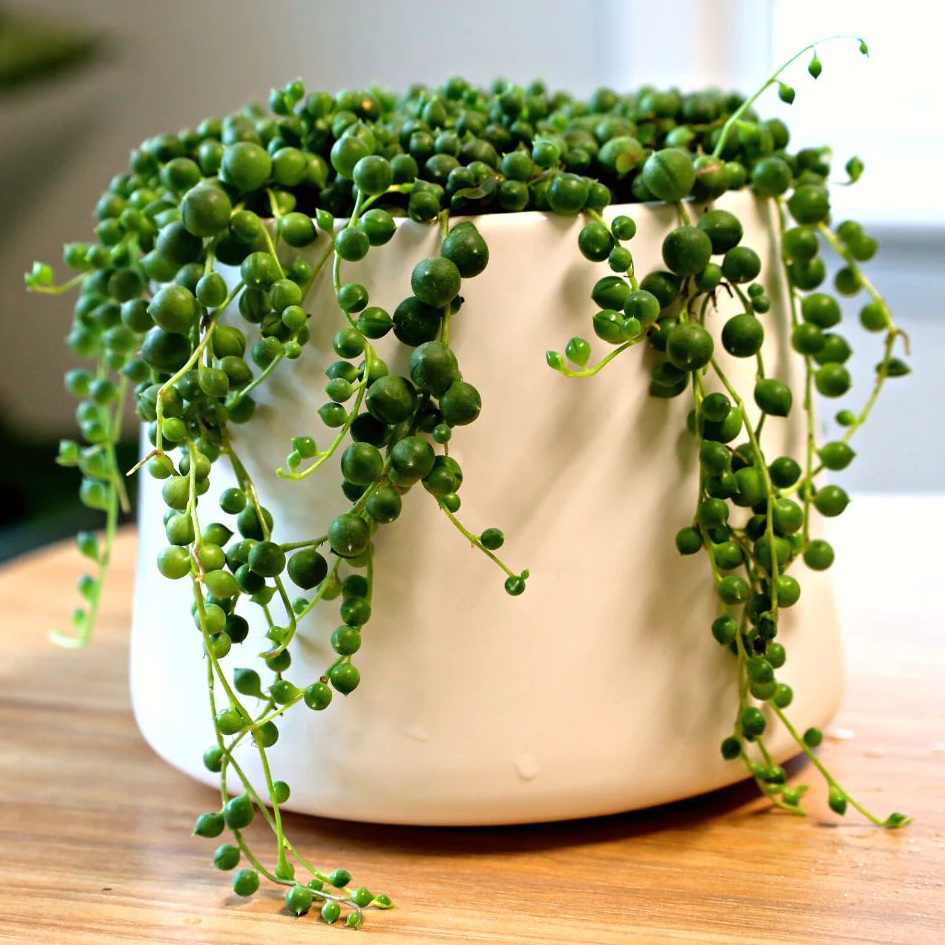
String of Pearls
Information SheetSenecio Rowleyanus
Size: Large, up to 2' tall.
Light: These plants are best grown in direct light.
Water: String of pearls are very drought tolerant and require infrequent watering.
Humidity: Can handle drier humidity because they are similar to succulents.
It is a relatively easy plant to grow and enjoy year-round as long as its cultural needs are met.
-
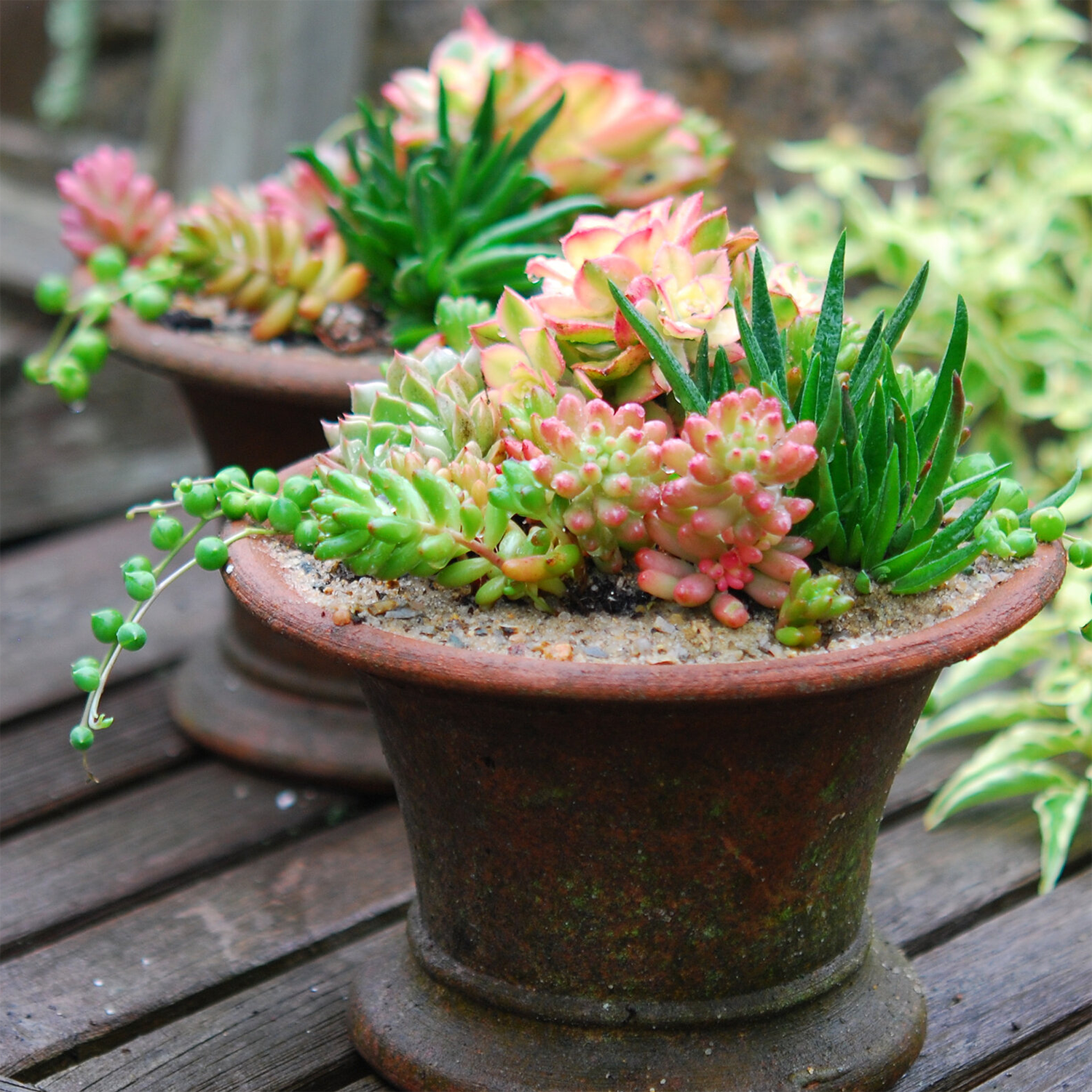
Succulents
Echieveria, Sedum, and Kalanchoe Species
Size: Varies by species, typically small to medium.
Light: Bright light with some direct sun.
Water: Keep lightly moist during growing season. Water sparingly in winter. Avoid water rosettes or crowns of plants. Wrinkled foliage indicates too dry.
Humidity: Average to dry room humidity.
Prefer to be planted in a cacti potting medium.
-
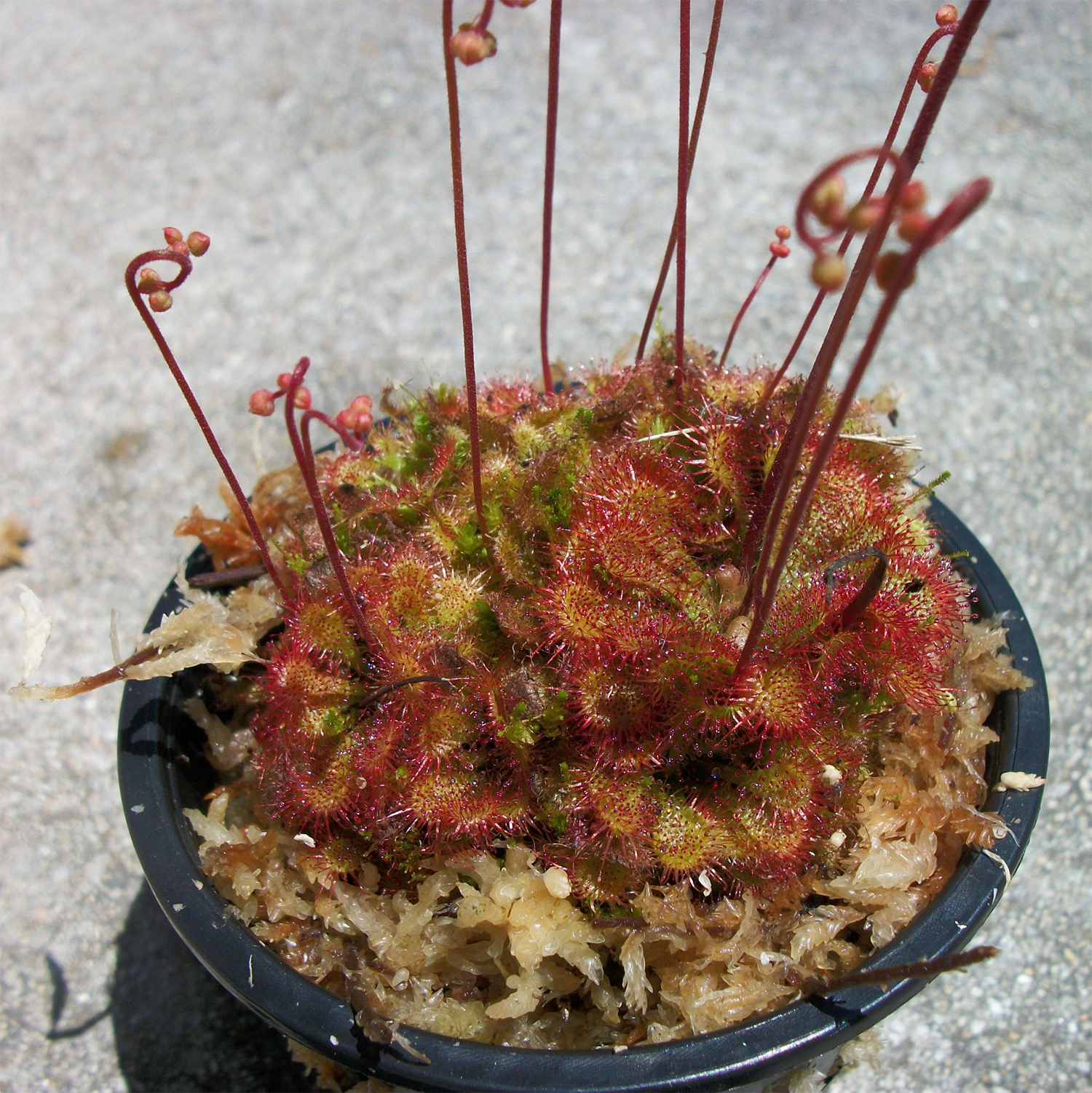
Sundew Carnivorous Plants
Information SheetDrosera
Size: Small, up to 7" tall.
Light: Drosera capensis and drosera spatulata thrive indoors on a bright, sunny windowsill. They also do very well when grown under bright artificial light.
Water: All sundews require mineral free water. Keep the soil wet at all times, preferably in standing water.
Humidity: Constant water provides the plant with plenty of humidity.
Sundews grow very well in terrariums.
-
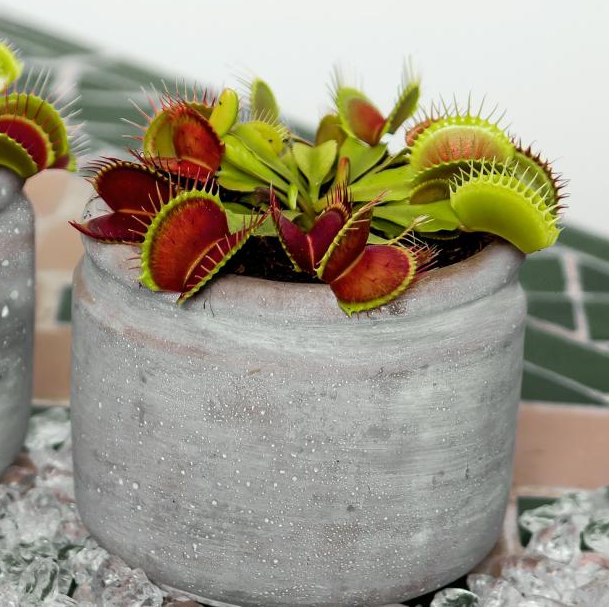
Venus Flytrap
Information SheetDionaea muscipula
Size: Small, up to 10" tall.
Light: Venus flytraps need full, direct sun to perform well. Place them on a bright sunny windowsill somewhere they can receive direct light.
Water: Venus flytraps need pure water, such as rainwater or distilled water to perform well. These plants appreciate being watered from the bottom like African violets in water filled trays.
Humidity: Above 50% humidity is best.
The traps are trigged by two tiny hairs within. When the hairs are triggered the trap shuts around its prey.
-
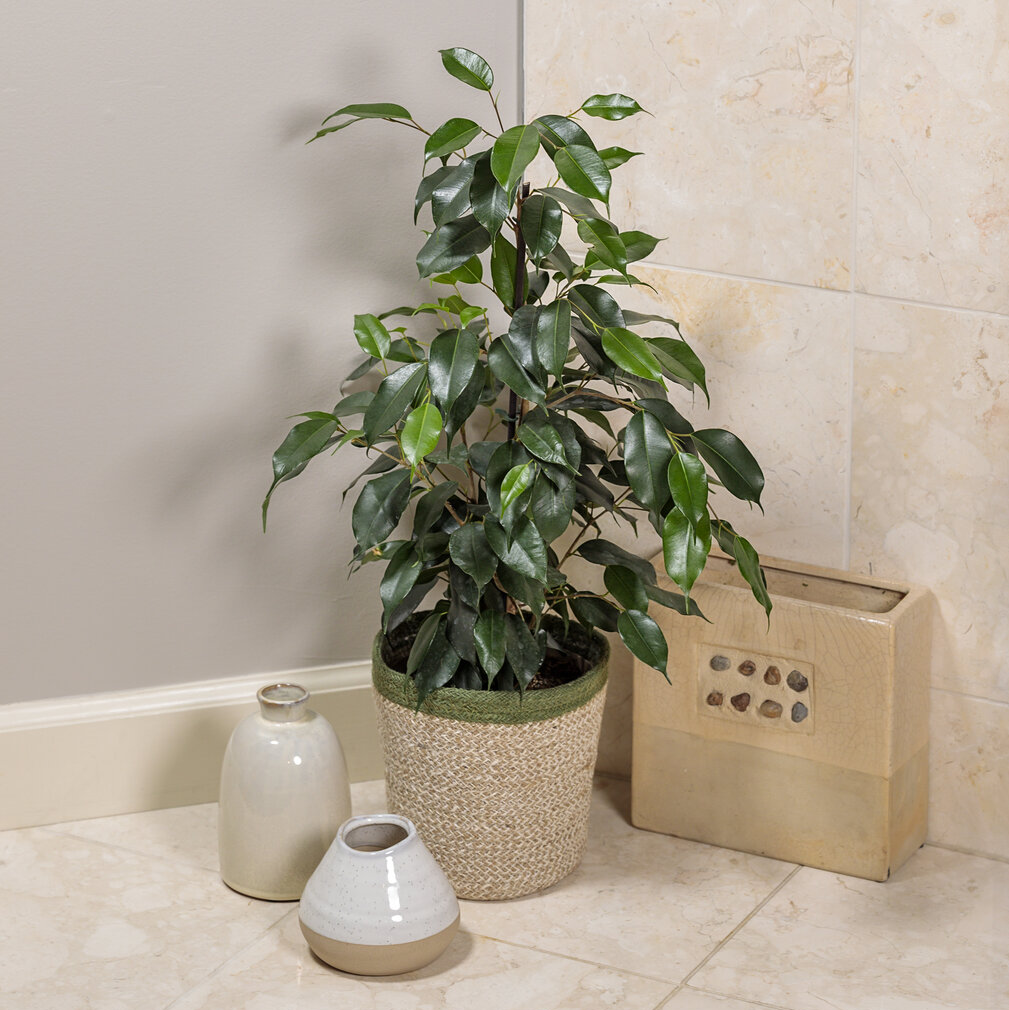
Weeping Fig
Ficus benjimina
Size: Large, growing up to 10′ indoors.
Light: Bright light.
Water: Allow to dry out slightly between watering. Keep drier in winter months. Does not tolerate soggy soil. Prefers distilled water.
Humidity: Moderate to high humidity.
One of the best plants for improving air quality.












































